Physical Address
304 North Cardinal St.
Dorchester Center, MA 02124
Inflammation of arteries and veins can occur in many inflammatory lung diseases, including infections. By convention, the diagnostic term pulmonary vasculitis is restricted to a relatively limited number of diseases in which vascular inflammation is thought to be a major component of the pathologic process. Most pulmonary vasculitides are believed to be immune-mediated diseases, although their etiology and pathogenesis continue to be elucidated. By best estimates, the overall annual incidence of the major forms of vasculitis is 48 to 184 case per 1 million. ,
When pulmonary vasculitis occurs, there is inflammation of the vessel wall, often accompanied by fibrin and sometimes, necrosis. Cuffing of blood vessels by inflammatory cells, a nonspecific finding, must be distinguished from infiltration of inflammatory cells into the media and intima of arteries and veins ( Fig. 11.1 ).
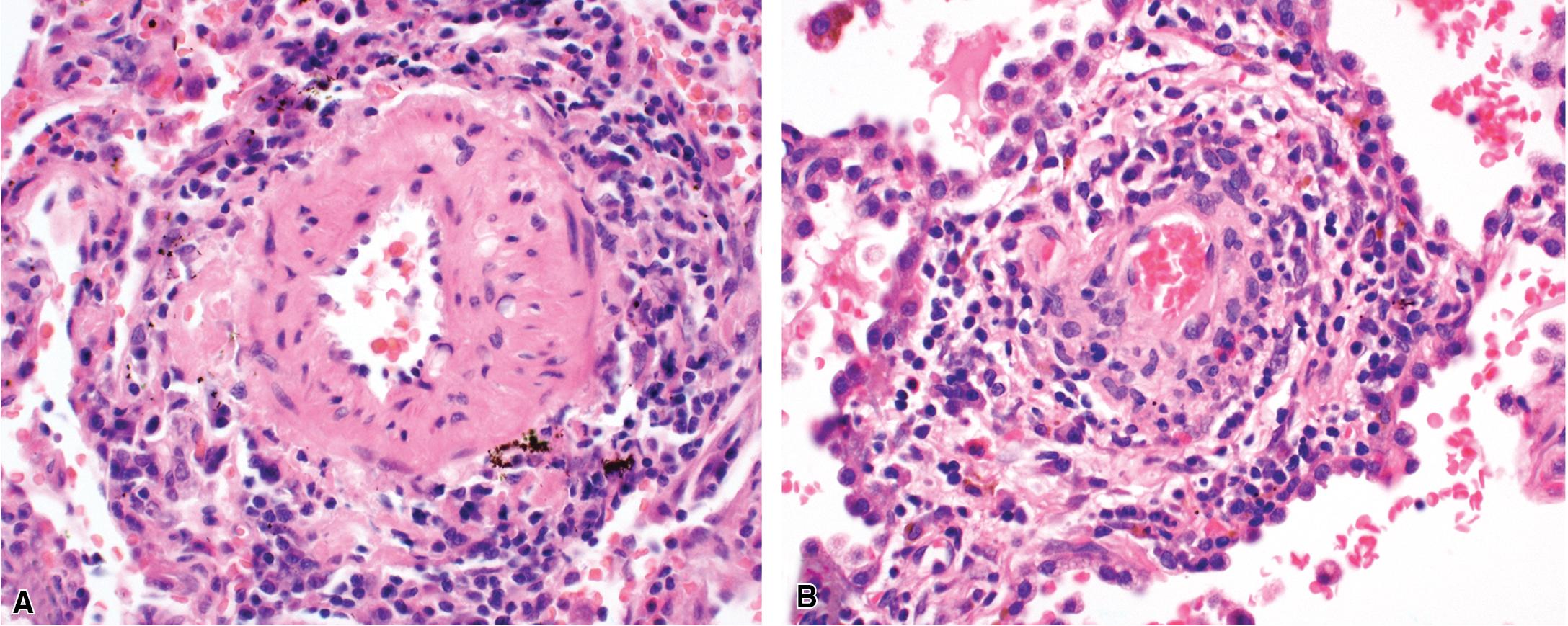
A diagnosis of pulmonary vasculitis carries a strong implication for immediate therapeutic intervention (typically immunosuppression) and therefore should never be made lightly. Furthermore, serologic and clinical correlation with the pathologic findings is essential for a correct diagnosis. Typical histologic examples of pulmonary vasculitis-capillaritis are shown in Fig. 11.2 .

The general category of pulmonary vasculitis includes a number of different diseases that can be more easily understood by dividing them into three main groups: (1) vasculitic syndromes that commonly involve the lung (e.g., granulomatosis with polyangiitis [GPA]/previously known as Wegener granulomatosis), (2) vasculitic disorders that rarely involve the lung (a much larger number), and (3) miscellaneous conditions that produce pulmonary vascular inflammation ( Box 11.1 ). ,
Vasculitis syndromes that commonly affect the lung
Granulomatosis with polyangiitis/Wegener granulomatosis
Eosinophilic granulomatosis with polyangiitis/Churg-Strauss syndrome
Microscopic polyangiitis
Vasculitis syndromes that uncommonly affect the lung
Necrotizing sarcoid granulomatosis
Polyarteritis nodosa
Small-vessel vasculitis
Takayasu arteritis
Henoch-Schönlein purpura (IgA vasculitis)
Behçet syndrome
Cryoglobulinemic vasculitis
Hypocomplementemic vasculitis
Idiopathic granulomatous arteritis
Giant cell arteritis
Disseminated visceral giant cell angiitis
Miscellaneous systemic disorders
Classic sarcoid
Collagen vascular disease
Inflammatory bowel disease
Malignancy
Diffuse pulmonary hemorrhage syndromes
Secondary or localized vasculitis
Pulmonary infection
Bronchocentric granulomatosis
Pulmonary hypertension
Interstitial lung diseases
Chronic eosinophilic pneumonia
Langerhans cell histiocytosis
Inflammatory pseudotumors and pseudolymphomas
Sequestration
Embolic material (intravenous drug abuse)
Drug or toxic substances
Transplantation
Radiation
Vascular involvement in lymphoproliferative disorders
Angiocentric immunoproliferative lesion (lymphomatoid granulomatosis)
Non-Hodgkin lymphoma
Intravascular malignant lymphoma
GPA, eosinophilic granulomatosis with polyangiitis (EGPA), previously known as Churg-Strauss syndrome (CSS), and microscopic polyangiitis (MPA) are the vasculitic syndromes that commonly affect the lung. These conditions correspond to the anti-neutrophilic cytoplasmic antibody (ANCA)- associated vasculitides (AAV). The conditions of bronchocentric granulomatosis and lymphomatoid granulomatosis historically have been grouped in the category of pulmonary angiitis and granulomatosis ; however, neither of these entities is currently thought to be a vasculitic condition. Bronchocentric granulomatosis is a morphologic pattern of airway inflammation that occurs in a variety of conditions, especially infection, and lymphomatoid granulomatosis is now known to represent a lymphoproliferative disease in which prominent vascular involvement occurs.
Vasculitic syndromes that rarely affect the lung include such diseases as necrotizing sarcoid granulomatosis, Takayasu arteritis, giant cell arteritis, and Behçet syndrome, among others. Necrotizing sarcoid granulomatosis was formerly regarded as one of the major vasculitic syndromes, but it is very rare and does not typically cause a systemic vasculitis, so it is now grouped with the syndromes that uncommonly affect the lung. Pulmonary vascular inflammation also occurs in a number of miscellaneous systemic disorders, in diffuse pulmonary hemorrhage syndromes, and in a variety of secondary or localized forms.
Vasculitic syndromes pose major challenges to the surgical pathologist. First, as with many nonneoplastic lung diseases, the diagnosis does not rest on pathology alone. Correlation among clinical, radiologic, and pathologic features is required for most of these entities. Second, because these are rare disorders, few pathologists have much experience with their diagnostic subtleties. Third, the pathologic features of these infrequently encountered conditions overlap with those of common inflammatory lesions, including necrotizing infectious granulomas produced by mycobacteria or fungi. Because most vasculitic syndromes are treated with immunosuppressive agents, separation from infectious conditions is essential. With the use of ANCA testing, the diagnosis often is suspected early in the course of disease, so biopsies may be obtained before the tissues show all of the classic histologic manifestations. In addition, partial treatment before the biopsy can alter the expected histologic findings. Finally, in many cases, the histopathologic findings may not be classic, requiring the recognition of subtle clues to suspect the diagnosis.
Three main patterns of disease dominate pulmonary vasculitis: (1) acute injury, (2) alveolar filling, and (3) nodules. Some forms may show all 3 patterns, but more commonly, one pattern dominates the presentation. The dominant patterns of histopathologic disease for each entity described in this chapter are presented in Table 11.1 .
| Acute Injury (Pattern 1) |
|
| Alveolar Filling (Pattern 4) |
|
| Nodules (Pattern 5) |
|
The major vasculitides that commonly affect the lung primarily include those classified under the heading of AAV as proposed in the 2012 International Chapel Hill Consensus Conference on the nomenclature of vasculitides. This classification adopted the nomenclature changes proposed by the American College of Rheumatology (ACR), the American Society of Nephrology (ASN), and the European League Against Rheumatism (EULAR), in particular with regard to Wegener granulomatosis, which is now known as GPA. This same classification system recommends the terminology EGPA for CSS.
As discussed later, certain vasculitides are associated with particular types of ANCA, and a classification based on ANCA positivity or negativity and ANCA subtype has been proposed.
GPA is a rare systemic inflammatory disease of unknown etiology that has vasculitis as a major histologic manifestation. GPA predominantly affects the upper and lower respiratory tract and the kidneys. Although this pattern of involvement is considered the so-called classic triad of GPA, more frequently only one or two sites may be involved. In one series reported by DeRemee and associates, involvement of all three sites was seen in only 14 of 50 patients. In a large study of 795 patients from the French Vasculitis Study Group Registry, at the time of initial presentation, 80.4% of patients had ENT involvement, 67.7% had lung involvement and 56.2% had renal involvement Limited GPA historically has been defined as disease involving the lungs without associated glomerular disease, although the term is also used to describe active disease without involvement that threatens the function of a vital organ or the patient’s life.
Despite the designation granulomatosis , well-defined granulomas without necrosis (sarcoid-like) are not a feature of this disease. As described in detail below, the necrotizing lesions of GPA have a peripheral zone of palisaded histiocytes, contrasting with the epithelioid histiocytes seen at the periphery of necrosis produced by mycobacteria or fungi ( Fig. 11.3 ). In fact, when well-formed (sarcoid-like) granulomas without necrosis are present in a potential case of GPA, another diagnosis should be considered (usually infection).
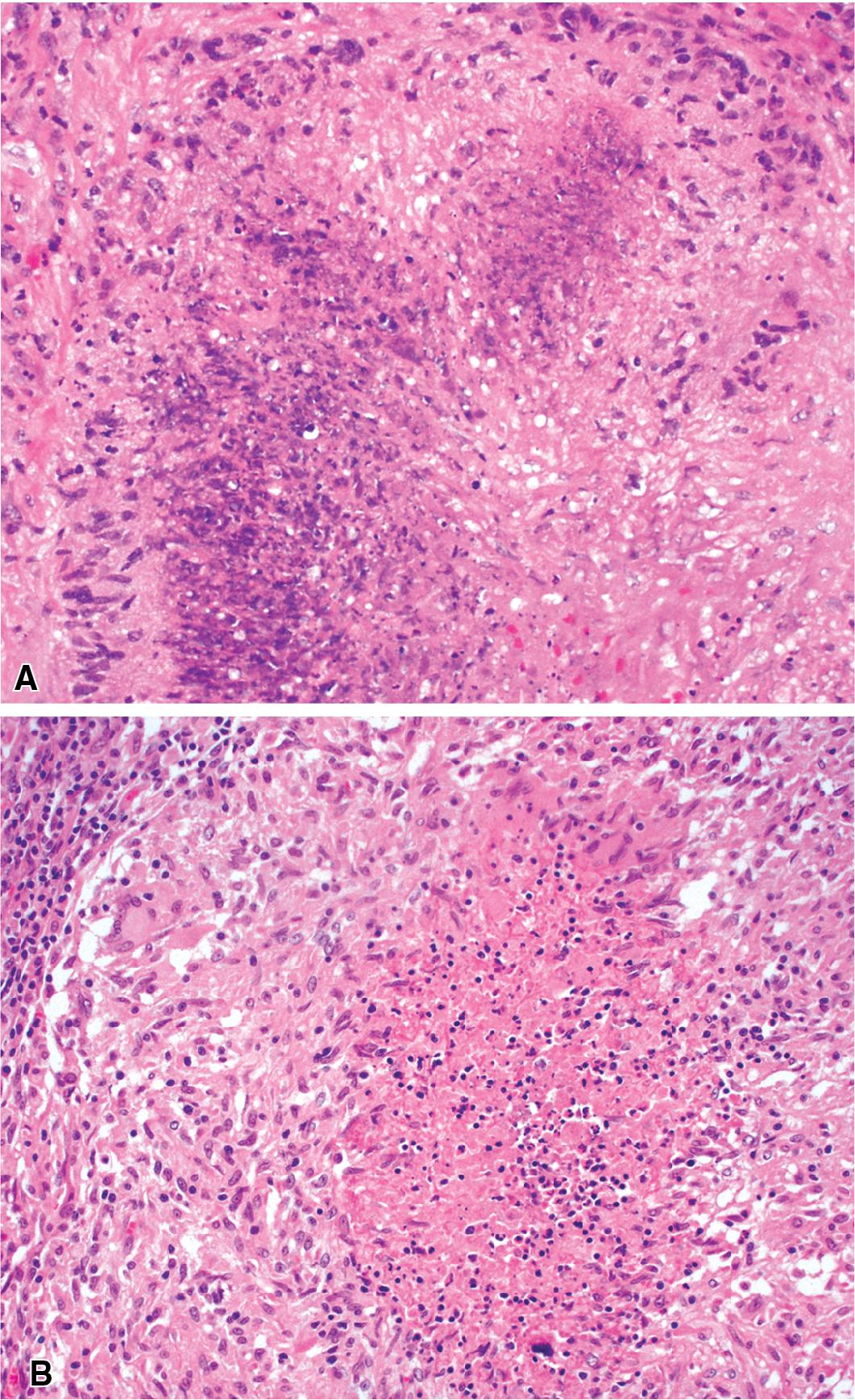
GPA affects about 1 in every 3 million people in the United States and 1 in 8.5 million people in the United Kingdom. There is debate as to whether GPA occurs more frequently during cold seasons, with some studies suggesting an increased occurrence in winter months. Other studies have disputed these results. The incidence of GPA appears to be influenced by latitude, with cases decreasing towards to equator and only rarely seen in East Asian regions. GPA has a higher prevalence in populations of predominantly of European ancestry, potentially implicating genetic factors, although environmental factors may also play a role. ,
GPA, as well as EGPA and MPA, are thought to have a complex pathogenesis, and it is unclear why the AAVs preferentially feature involvement of the small vessels. A primary theory of pathogenesis involves loss of antigenic tolerance to neutrophil primary granule proteins, that is, leukocyte proteinase 3 (PR3) or myeloperoxidase (MPO) are involved, which leads to ANCA-mediated neutrophil activation and recruitment. The ANCA activated neutrophils are then thought to localize to microvascular beds, inducing injury and releasing autoantigens for presentation by antigen-presenting cells which are then recognized by effector T-cells, thus mediating further cell injury. PR3 and MPO, in addition to being autoantigens, also have damaging effects on the endothelium in microvascular inflammation. ANCAs additionally bind to intermediate monocytes that release pro-inflammatory cytokines. Loss of B-cell tolerance and reduced expression of genes linked to T-cell exhaustion may promote ongoing chronic and/or relapsing disease. An association with major histocompatibility complex (MHC) genes has been observed with GPA and MPA, particularly the HLA-DPB1*04:01 allele. Genetic variants in SERPINA1 , which encodes alpha-1-antitrypsin, and PRTN3 , which encodes PR3, have been shown to cause increased plasma levels of PR3, raising the possibility that increased levels of PR3 may be a driver of loss of tolerance. An association with genes such as PTPN22, which may be encountered in other autoimmune diseases, may also suggest a genetic predisposition. Studies have also suggested that GPA and MPA may be genetically distinct and the European Vasculitis Genetics Consortium has suggested that the ANCA-specificity was perhaps more important than the clinical syndrome; however, genetic variants have been found to be common to both PR3 and MPO associated AAVs suggesting a shared genetic component also. Environmental causes have been suggested primarily based on small studies, although no single environmental factor has been identified as conferring a population-attributable risk.
Infection has also been suggested as a possible trigger, potentially by promoting loss of tolerance via autoantigen exposure by the formation of neutrophil extracellular traps and by the priming of neutrophils for ANCA-induced activation, although further study is warranted. It has also been noted that a subtype of ANCA directed against lysosomal membrane–associated protein 2 (LAMP-2) is found in more than 90% of patients with pauci-immune necrotizing glomerulonephritis and frequently coexists with anti-proteinase-3 and anti-myeloperoxidase. LAMP-2 has been observed to activate neutrophils and cause injury to vascular endothelial cells in the absence of neutrophils. LAMP-2 cross-reacts with the bacterial adhesin FimH, and one study found that infection with bacteria expressing FimH occurred in 69% of patients in whom ANCA-positive glomerulonephritis subsequently developed. , Although such findings suggest a potential link between infection and the production of ANCA, further study is needed in regard to a link between infection and GPA. Interestingly, at least one case report poses a possible scenario of SARS-CoV-2-induced GPA, and SARS-Co-V2 infection has been shown to trigger an autoimmune response, including the presence of ANCA, although additional study of this phenomenon is ongoing.
GPA occurs at any age but typically is a disease of adults, with a mean age of 50 years. A list of the clinical manifestations of GPA is presented in Table 11.2 . Body sites most commonly affected are the head and neck region, followed by the lung, kidney, and eye. , Patients may experience a number of other complaints such as hoarseness, stridor, earache, hearing loss, otorrhea, cough, dyspnea, hemoptysis, or pleuritic pain. Pulmonary symptoms in the absence of upper respiratory tract manifestations are unusual. Destructive inflammation of the nose may result in a saddle nose deformity. In addition, patients may exhibit more generalized systemic signs and symptoms including malaise, fatigue, arthralgias, fever, cutaneous lesions, weight loss, and peripheral neuropathy. Rarely GPA may involve the salivary glands, pancreas, breast, mediastinum, gastrointestinal tract, prostate and urethra, vagina and cervix, heart, spleen, or peripheral or central nervous system. ,
| Frequency (%) | ||
|---|---|---|
| Manifestation | At Presentation | During Course of Disease |
| Head and neck manifestations | 73 | 92 |
|
51 | 85 |
|
36 | 68 |
|
25 | 44 |
|
14 | 42 |
|
8 | 16 |
|
1 | 14 |
|
3 | 10 |
| Pulmonary manifestations | 45 | 85 |
|
23 | 66 |
|
22 | 59 |
|
19 | 46 |
|
12 | 30 |
|
10 | 28 |
| Renal manifestations | 18 | 77 |
| Eye manifestations | 15 | 52 |
|
5 | 18 |
|
1 | 18 |
|
6 | 16 |
|
2 | 15 |
|
3 | 11 |
|
0 | 8 |
|
0 | 4 |
|
0 | 1 |
|
0 | 2 |
| Systemic manifestations | ||
|
32 | 67 |
|
23 | 50 |
|
13 | 46 |
|
15 | 35 |
|
1 | 15 |
|
1 | 8 |
|
2 | 6 |
The most frequent abnormality on pulmonary function testing is airflow obstruction, often associated with a reduced diffusing capacity of the lung for carbon monoxide, but restrictive or mixed patterns can occur. When significant airflow obstruction is identified, patients may be at risk for tracheal obstruction or lobar collapse secondary to bronchial wall damage resulting from the disease.
Nonspecific abnormalities on general laboratory tests are often present in patients with GPA. The most common of these include leukocytosis, thrombocytosis (>400,000 cells/μL), marked elevation of the erythrocyte sedimentation rate, and normochromic normocytic anemia. The diagnosis of GPA has been dramatically aided by the discovery and use of serum ANCA.
ANCA testing is most commonly performed by indirect immunofluorescence (IF). Two major IF patterns occur as expressions of ANCA ( Fig. 11.4 ): the cytoplasmic or classic type (c-ANCA) and the perinuclear type (p-ANCA). The c-ANCA pattern is associated with GPA and is present in 65% to 75% of patients with active generalized disease. Partial or complete remission of disease is reflected in a lower frequency of a positive test result, but 30% to 40% of patients in complete remission still have identifiable antibodies. The p-ANCA pattern can be seen in up to 30% of patients with GPA, but it is more characteristic of idiopathic necrotizing and crescentic glomerulonephritis, MPA, polyarteritis nodosa (PAN), and EGPA. Approximately 5% of patients with GPA will be ANCA negative.
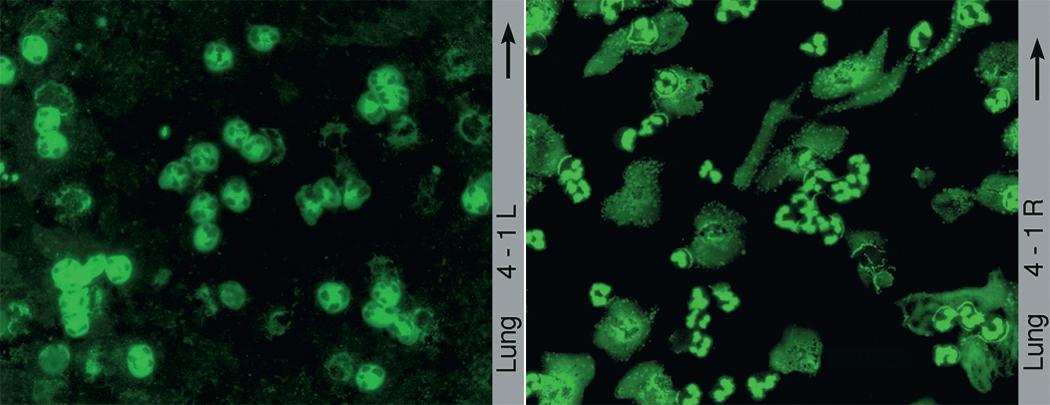
The ANCA IF patterns have been shown to correspond to specific antigen immunoreactivities; c-ANCA typically has specificity for leukocyte proteinase-3 (PR3-ANCA), whereas most p-ANCAs have a specificity for myeloperoxidase (MPO-ANCA). PR3-ANCA and MPO-ANCA may be detected by enzyme-linked immunoabsorbent assays (ELISA) or, less commonly, other solid phase antigen assays. Such antigen specific assays are now generally recommended for initial screening instead of IF. , Studies have shown no significant difference in the lung biopsy findings from GPA patients with c-ANCAs versus those with p-ANCAs. , Levels of c-ANCA in the bronchoalveolar lavage fluid have not been shown to be a more specific predictor of GPA or of the level of disease. Importantly, the presence or absence of a positive testing for c-ANCA or PR3-ANCA alone is not sufficiently specific to make or exclude the diagnosis of GPA, as both may occasionally be encountered in patients with other vasculitic syndromes or infection.
Most patients with pulmonary disease have multiple opacities ( Figs. 11.5 and 11.6 ) in the form of well-marginated nodules or masses of variable size (0.5–10 cm). Lesions may wax and wane over time. Most occur in the lower lobes. Poorly defined or even spiculated nodules may also be seen. Cavitation of nodules occurs in 25% to 50% of cases, with cavity walls typically being thick and irregular. Such lesions may evolve into thin-walled cysts or disappear completely with therapy. , GPA is often included in the differential diagnosis for interstitial lung disease because multifocal, ill-defined parenchymal consolidations can occur (with or without cavitation) and diffuse reticular and nodular interstitial opacities have also been reported. ,
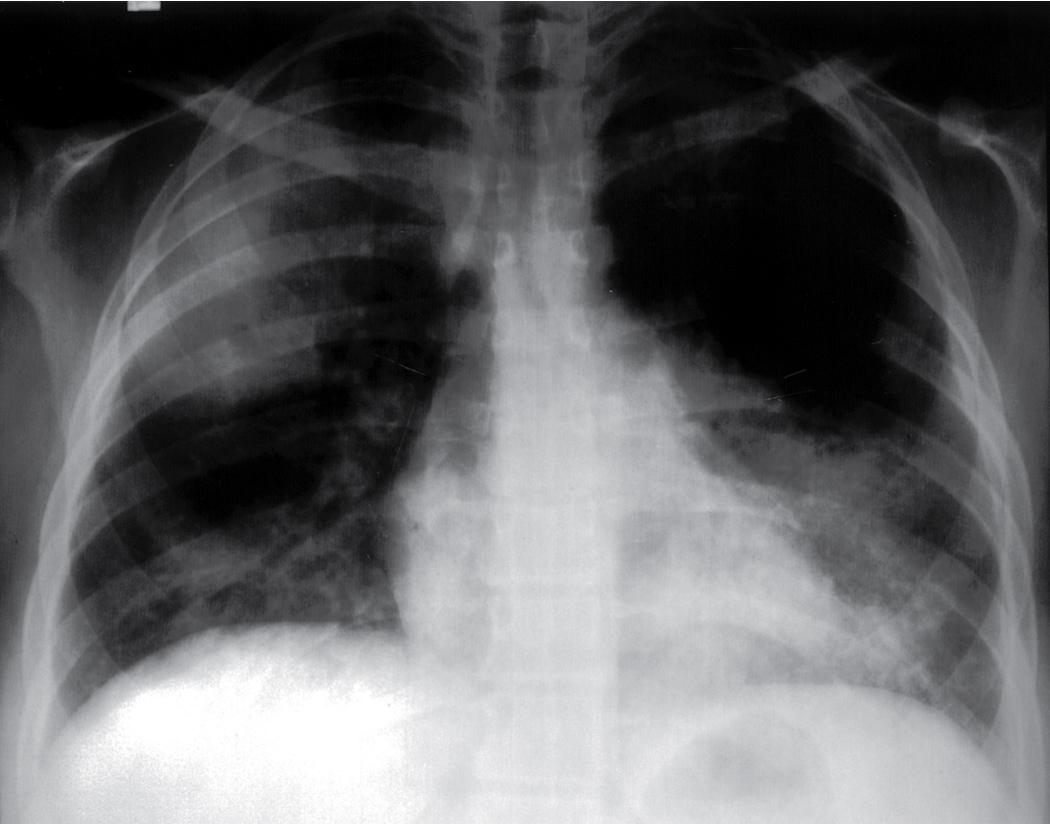
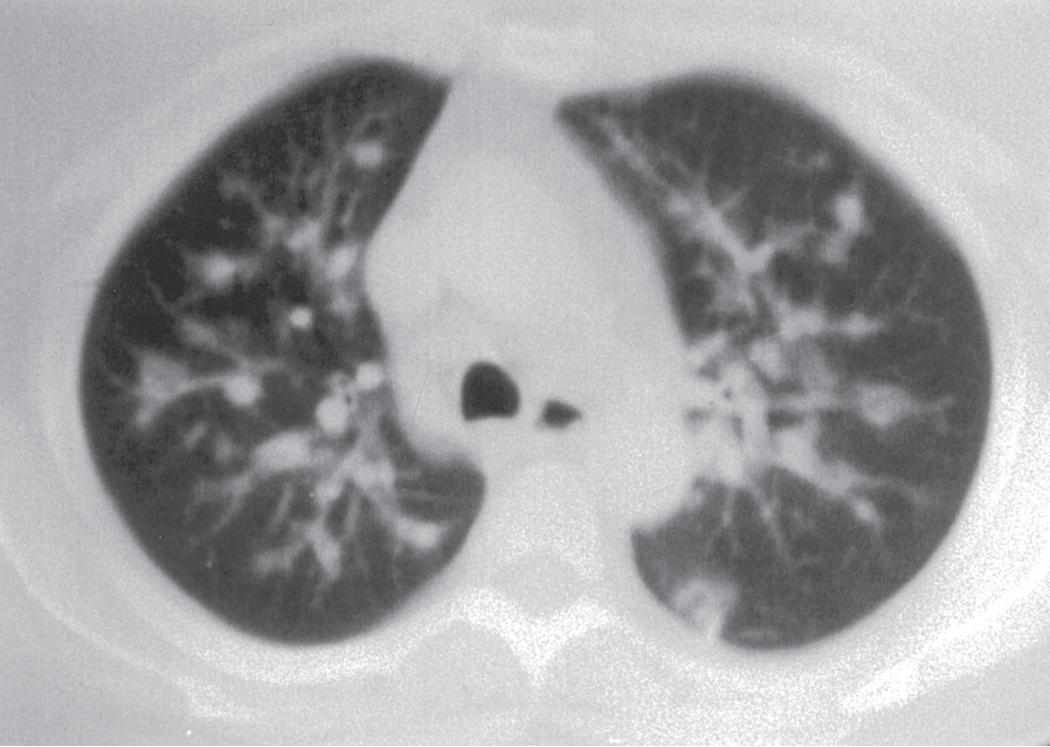
Patients with GPA may present initially with pulmonary hemorrhage. In this setting, diffuse infiltrates on chest radiographs and diffuse air space opacities on computed tomograms are observed ( Fig. 11.6 ). In children, pulmonary hemorrhage is a common presentation of GPA, whereas pulmonary nodules occur less frequently in pediatric patients.
Pleural effusion accompanies GPA in 20% to 50% of cases, sometimes with focal pleural thickening. Hilar or mediastinal lymphadenopathy is an unusual finding in GPA and, when significant, should raise concern for an alternate diagnosis. On rare occasions, GPA occurs as a solitary pulmonary nodule (with or without cavitation), or as an isolated area of consolidation.
Computed tomography (CT) provides optimal visualization of the number, location, and morphologic characteristics of the pulmonary abnormalities in GPA. Well-marginated nodules and masses, sometimes with spiculated borders, are typical findings. A feeding vessel is seen in 88% of nodules ( Fig. 11.6 ), consistent with the angiocentric nature of this disorder. Cavitation is identified in 50% of cases. Another very common finding in GPA is wedge-shaped peripheral opacities mimicking the CT appearance of infarct. Other, less common radiologic presentations include air bronchograms and the CT halo sign (ground-glass opacity surrounding a pulmonary nodule or mass). , Stenosis of the trachea or large airways may occur in short or long segments and may be complicated by partial or complete lobar collapse. , ,
GPA is characterized by the presence of multiple bilateral pulmonary nodules, often with cavitation ( Fig. 11.7 ; see also Fig. 11.6 ). Solid nodular zones of consolidation with areas of punctate or geographic necrosis are typical findings ( Figs. 11.8 and 11.9 ). GPA can rarely present with a solitary lung lesion, but solitary granulomatous disease is more likely to be of infectious origin. When dealing with a solitary granulomatous lung nodule, a combination of both the classical histology and typical clinical or serologic findings of GPA should be present before making a diagnosis. Even when special stains for organisms and cultures are negative, most of these solitary lesions represent old fungal or mycobacterial infection. Rarely the lesions of GPA may predominantly involve bronchi. When acute lung hemorrhage is prominent, the cut surface of the lung is bloody and dark red.

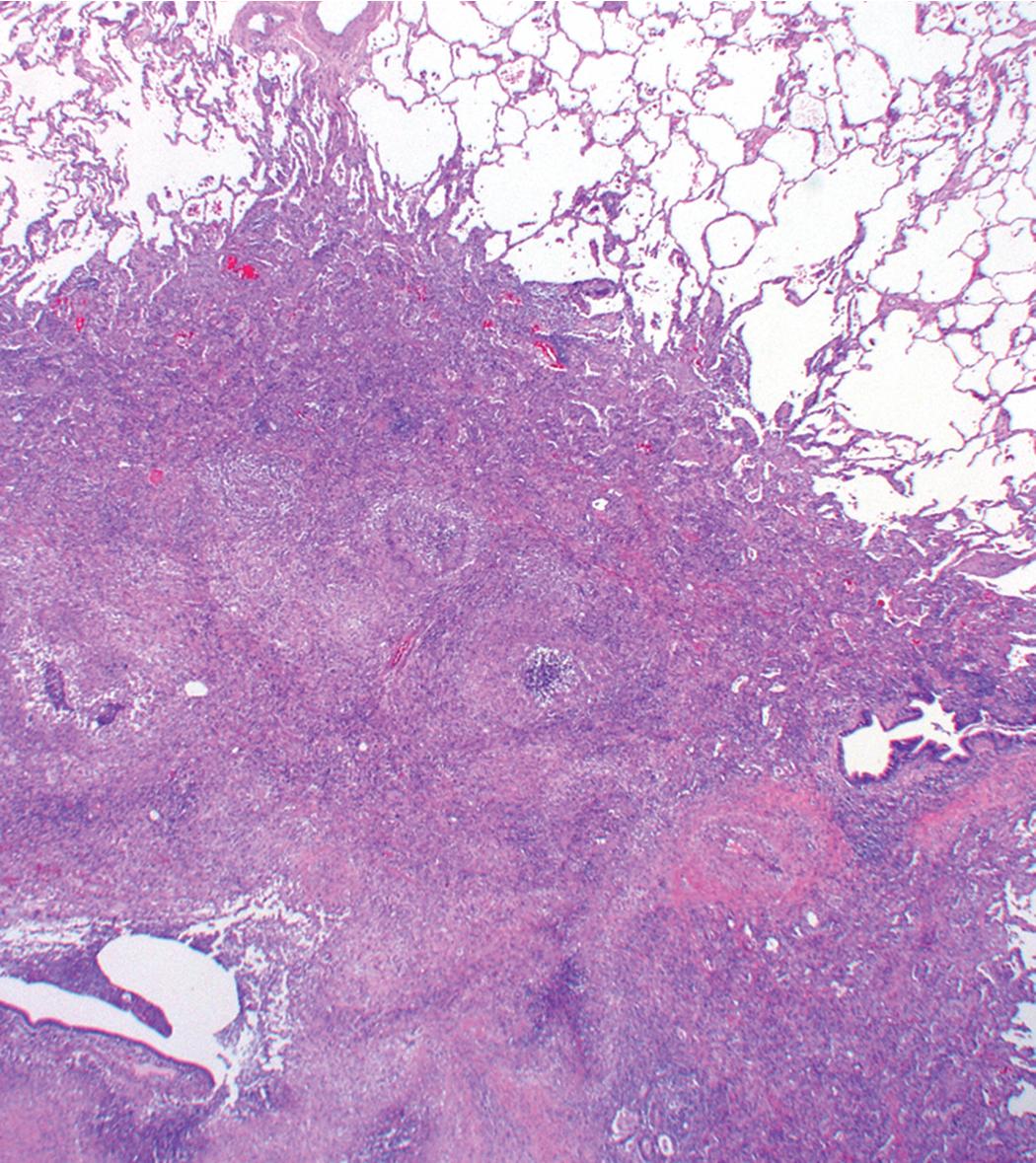
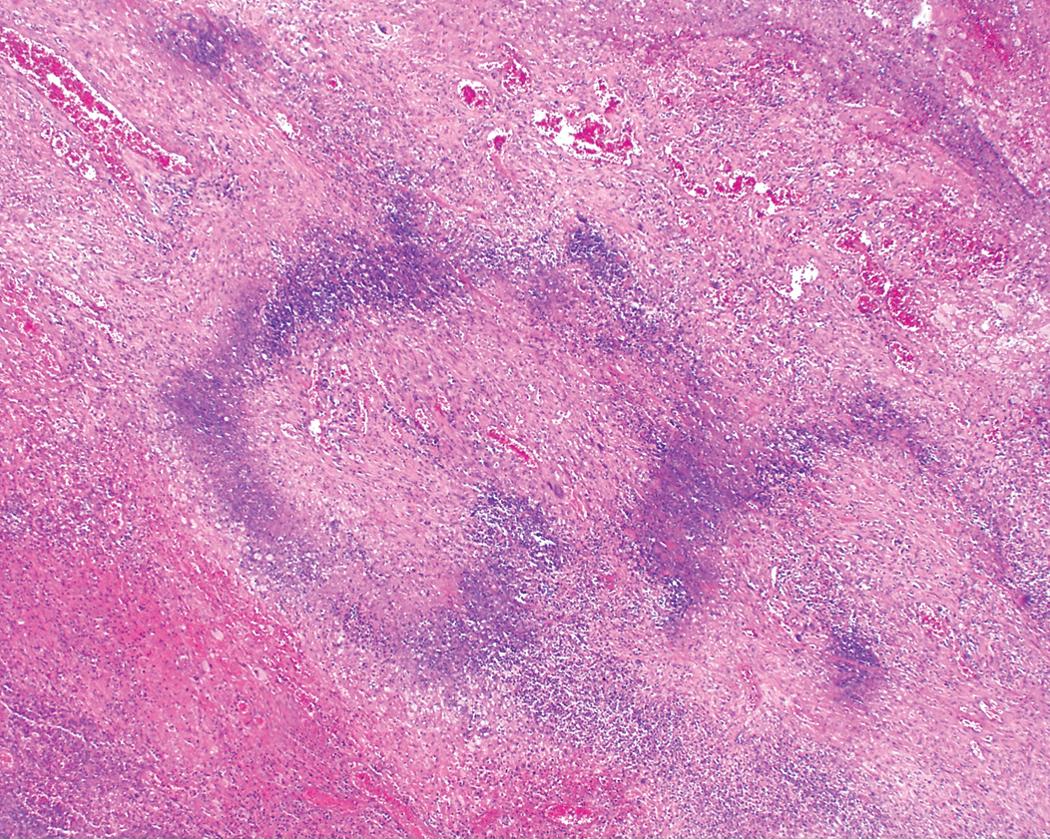
At scanning magnification, the pulmonary lesions of GPA simulate their radiologic appearance (see Fig. 11.8 ). The classic findings consist of nodular areas of consolidation with variable zones of necrosis. Major diagnostic criteria, presented in Box 11.2 , include parenchymal necrosis (see Fig. 11.9 ), vasculitis ( Fig. 11.10 ), and granulomatous inflammation ( Fig. 11.11 ). Another important feature is a mixed inflammatory infiltrate composed of neutrophils, lymphocytes, plasma cells, macrophages, giant cells, and eosinophils ( Fig. 11.12 ). Parenchymal necrosis can take the form of neutrophilic microabscesses ( Fig. 11.13 ) or large zones of geographic necrosis (see Fig. 11.9 ). The neutrophilic microabscesses are a characteristic histologic feature that can be found within the mixed inflammatory infiltrate or within fibrous connective tissue including the adventitial collagen of larger arteries and veins and the pleura. Early microabscesses may consist of a small collection of neutrophils surrounding a focus of degenerated, often hypereosinophilic, collagen.
Arteritis, venulitis, capillaritis
Six types of inflammation: acute, chronic, necrotizing granulomatous, nonnecrotizing granulomatous, fibrinoid necrosis, cicatricial changes
Microabscess
Geographic necrosis
Microabscess surrounded by granulomatous inflammation
Palisading histiocytes
Scattered giant cells
Poorly formed granulomas
Sarcoid-like granulomas (rare)
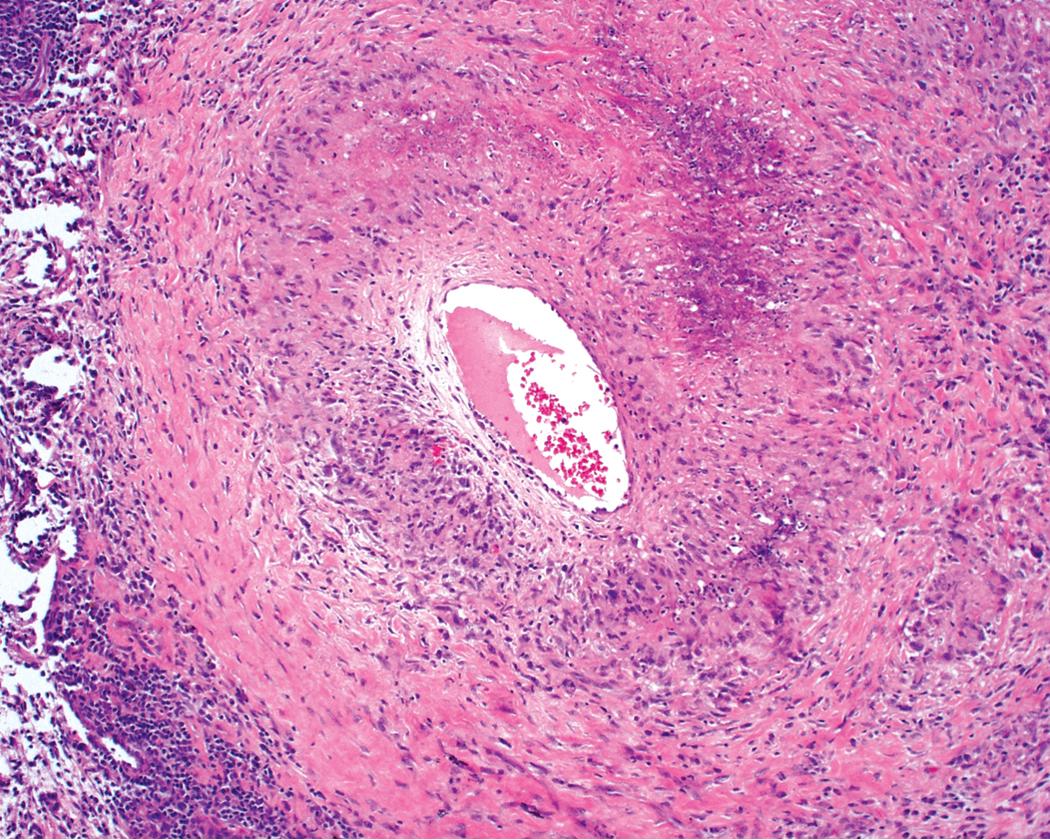
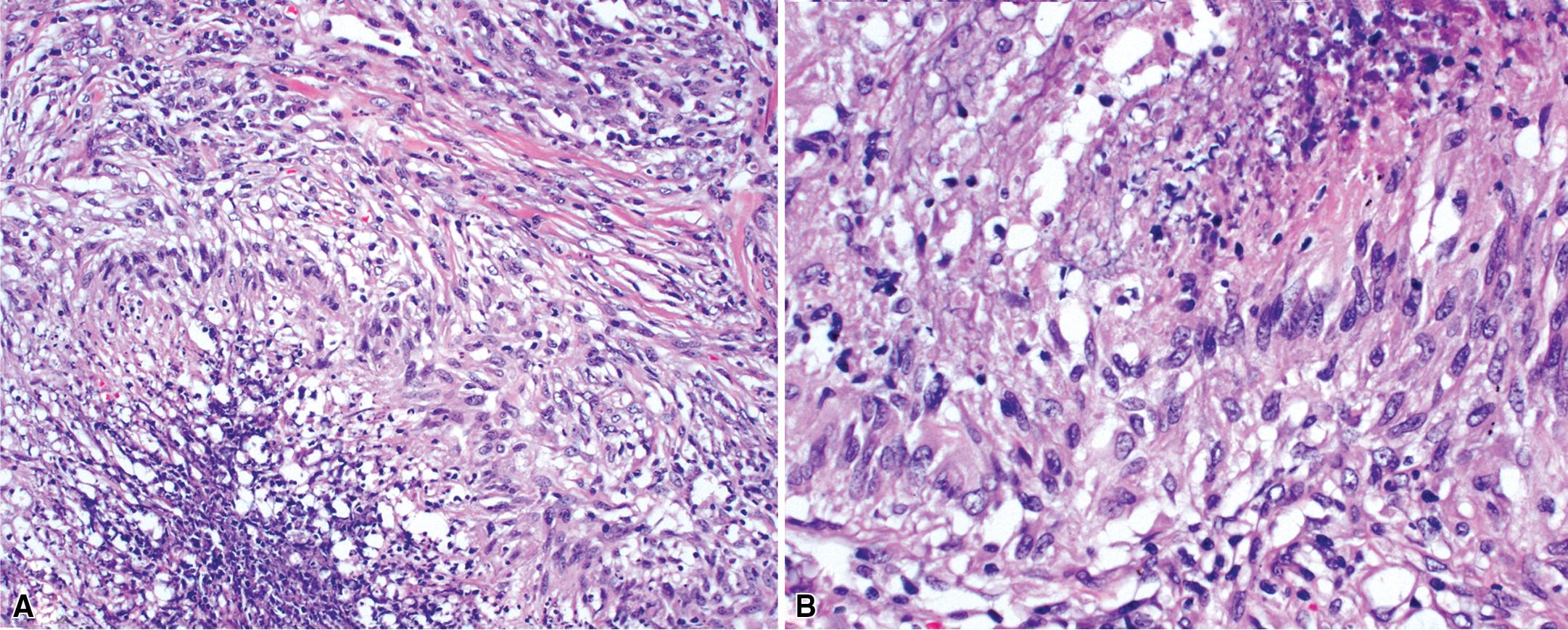
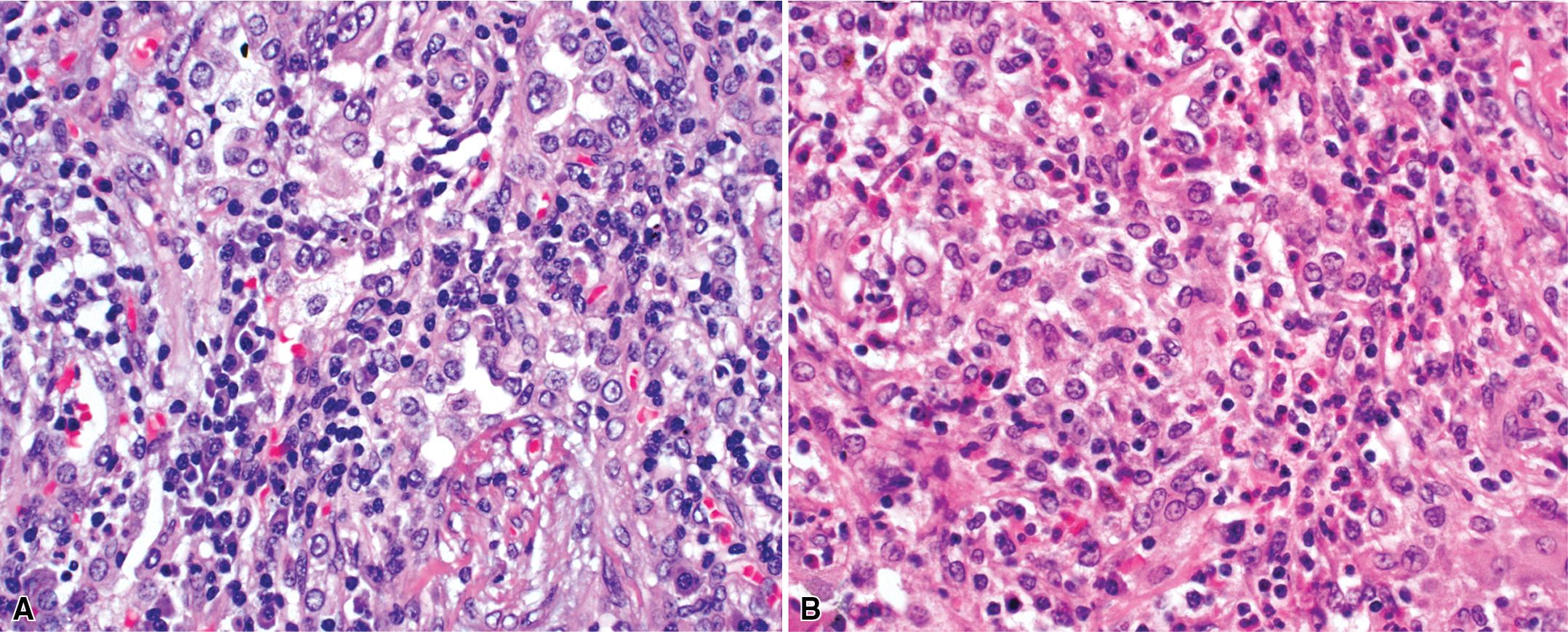
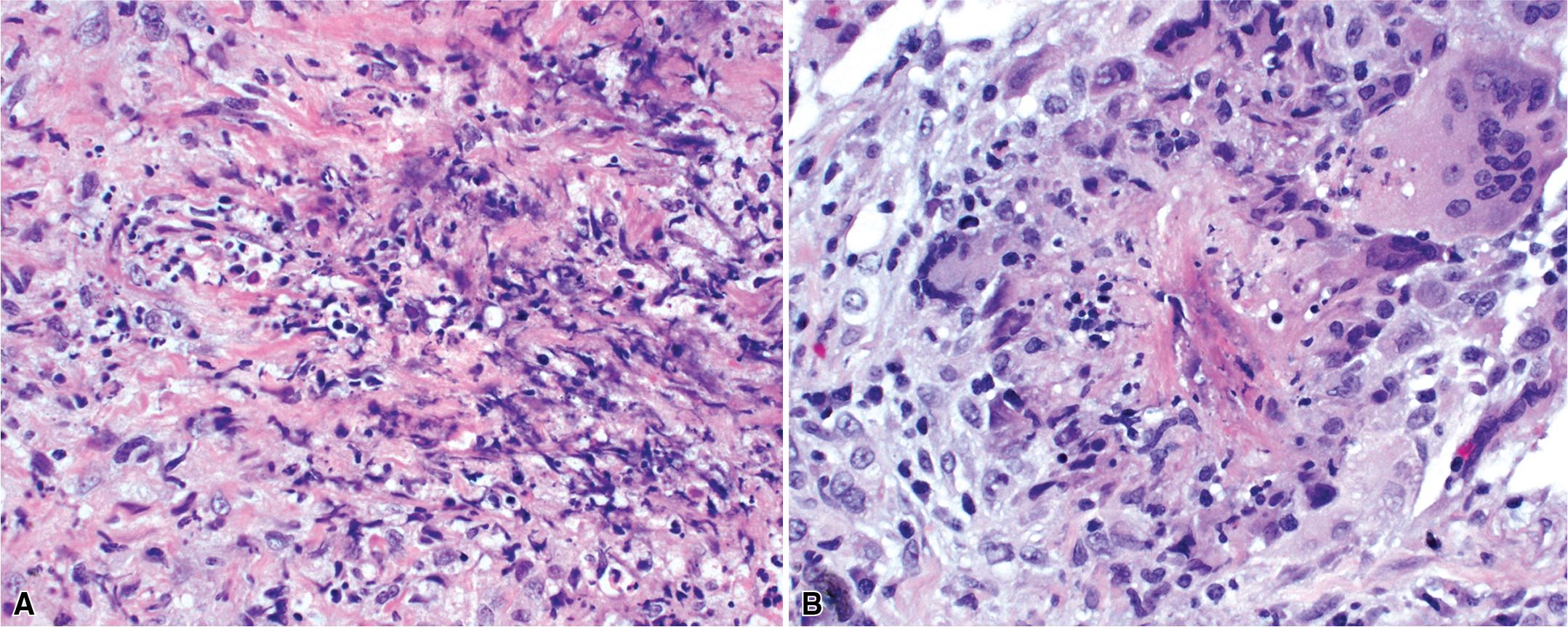
Neutrophil microabscesses surrounded by palisading granulomas are distinctive and in the appropriate morphologic and clinical context are highly suggestive of GPA.
As illustrated in Fig. 11.9 , the classic geographic necrosis of GPA is typically basophilic, owing to the presence of numerous necrotic neutrophils. The necrotic centers of GPA lesions often lack the ghosted image of lung structure, a diagnostic clue useful in the case with atypical features ( Fig. 11.14 ). This likely occurs because the necrotic zones of GPA generally are not the result of infarct-like zonal parenchymal necrosis but rather occur by progressive expansion of collagen necrosis.
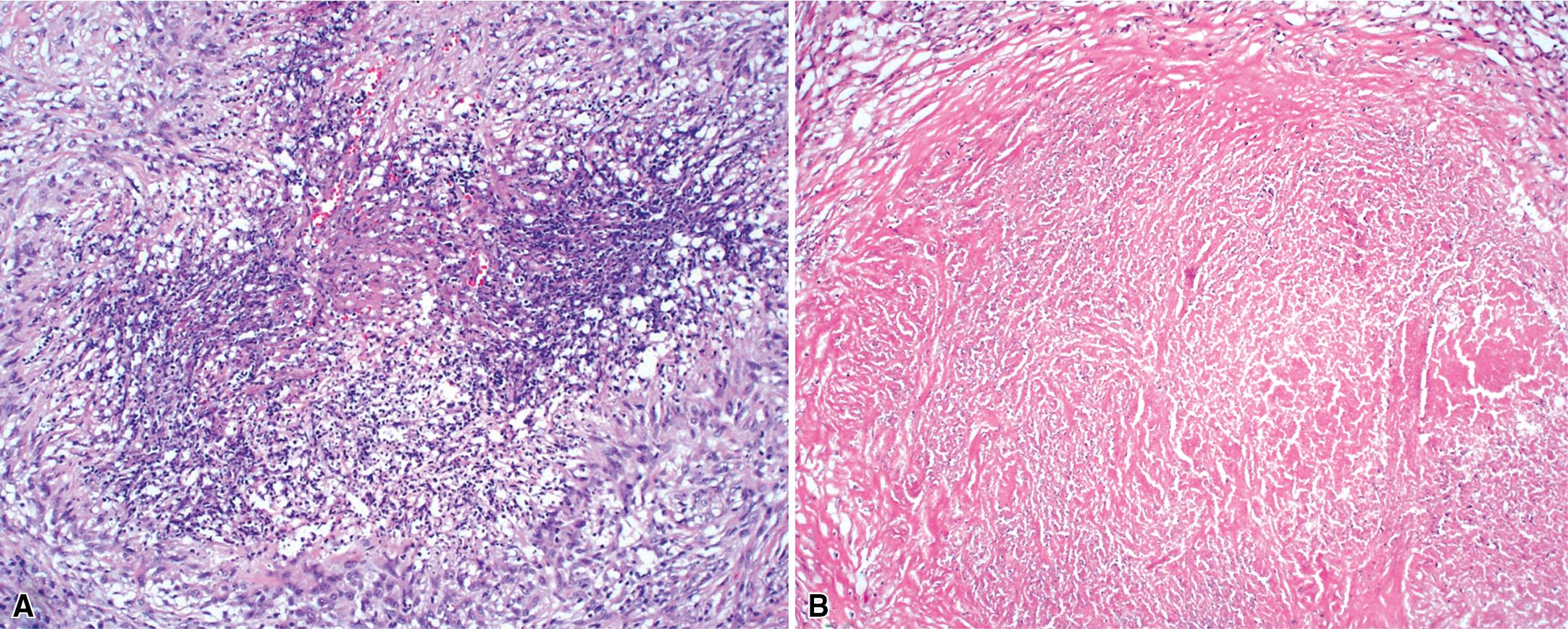
The granulomatous inflammation of GPA typically includes giant cells scattered randomly or in loose aggregates. Also commonly observed are palisaded histiocytes ( Fig. 11.15 ), giant cells lining the border of geographic necrosis or microabscesses, and microgranulomas consisting of small foci of palisaded histiocytes arranged in a cartwheel pattern around a central nidus of necrosis ( Fig. 11.16 ). The presence of tightly cohesive, sarcoid-like granulomas is very rare in GPA and suggests infection or necrotizing sarcoid. Also, the presence of granulomas without associated necrosis favors an infectious etiology over GPA. , ,
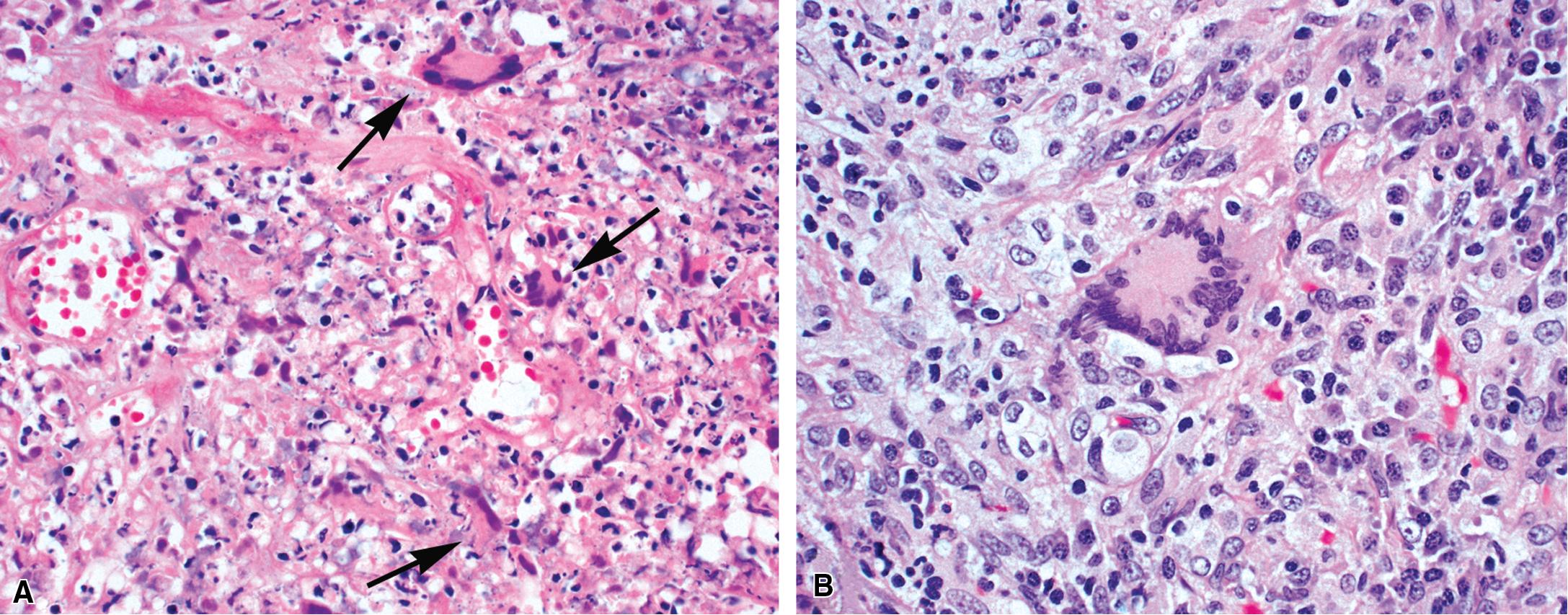
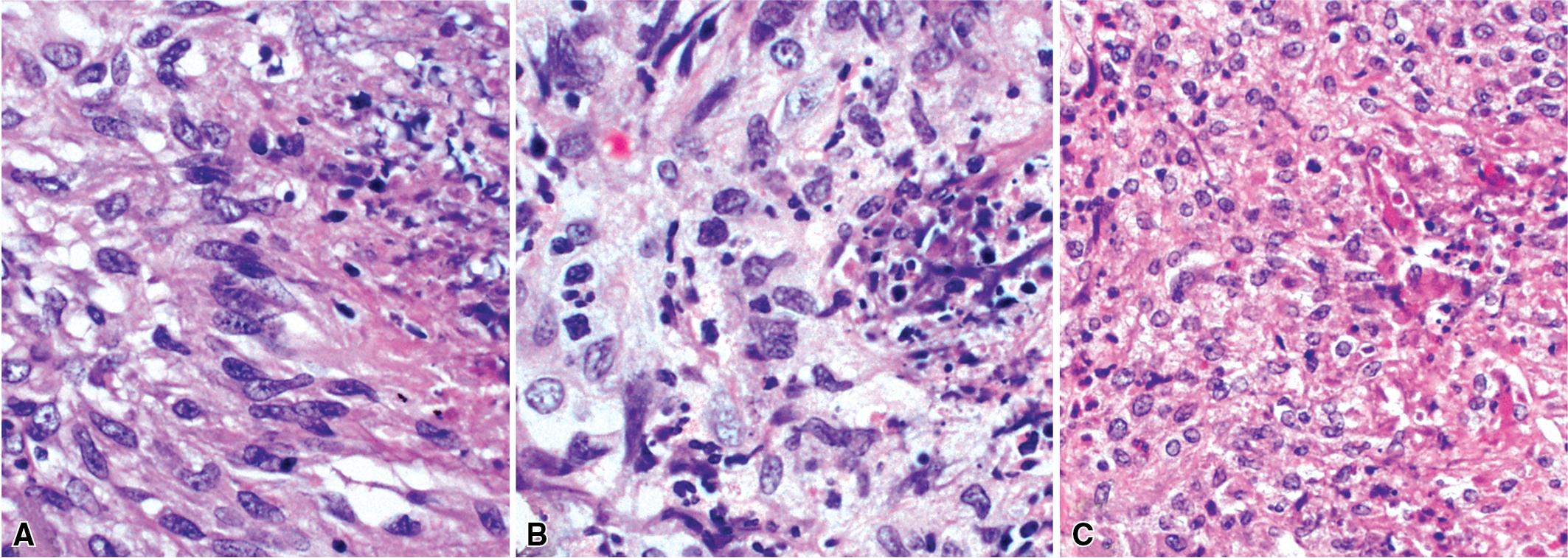
The vasculitis of GPA typically affects small arteries and veins up to 5 mm in diameter. When vasculitis is seen in the surgical biopsy, it most often occurs within the dense inflammatory infiltrate surrounding nodular or geographic areas of necrosis ( Fig. 11.17 ). Vasculitis in GPA may comprise a variety of inflammatory cells including acute or chronic mural inflammation, necrotizing stellate granulomas, nonnecrotizing stellate granulomas, and giant cells. Cicatricial changes consisting of mural fibrosis or luminal obliteration may be seen in specimens following therapy. Destruction of the vascular elastic laminae is commonly observed ( Fig. 11.18 ). Sometimes the inflammation is limited to the endothelium (endothelialitis) and subendothelial aspect of the vessel wall. Despite these potential vascular changes, if necrotizing vasculitis is held as a requirement for the diagnosis, many cases of GPA will be missed.
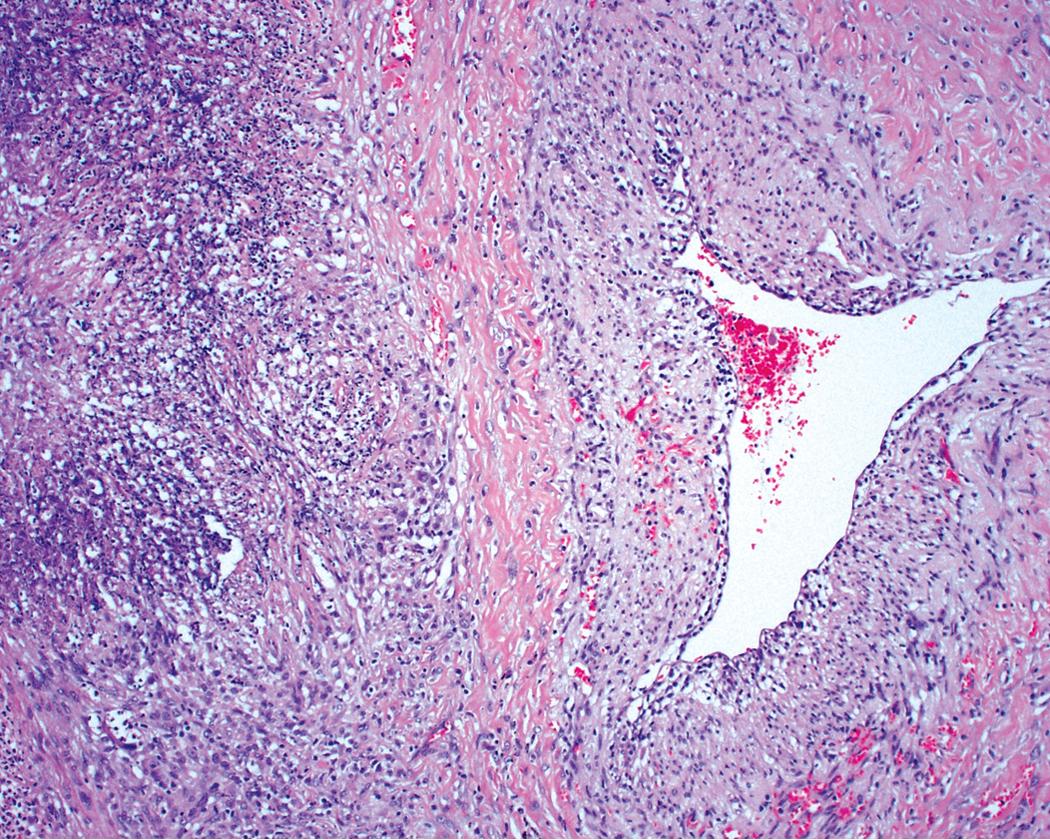
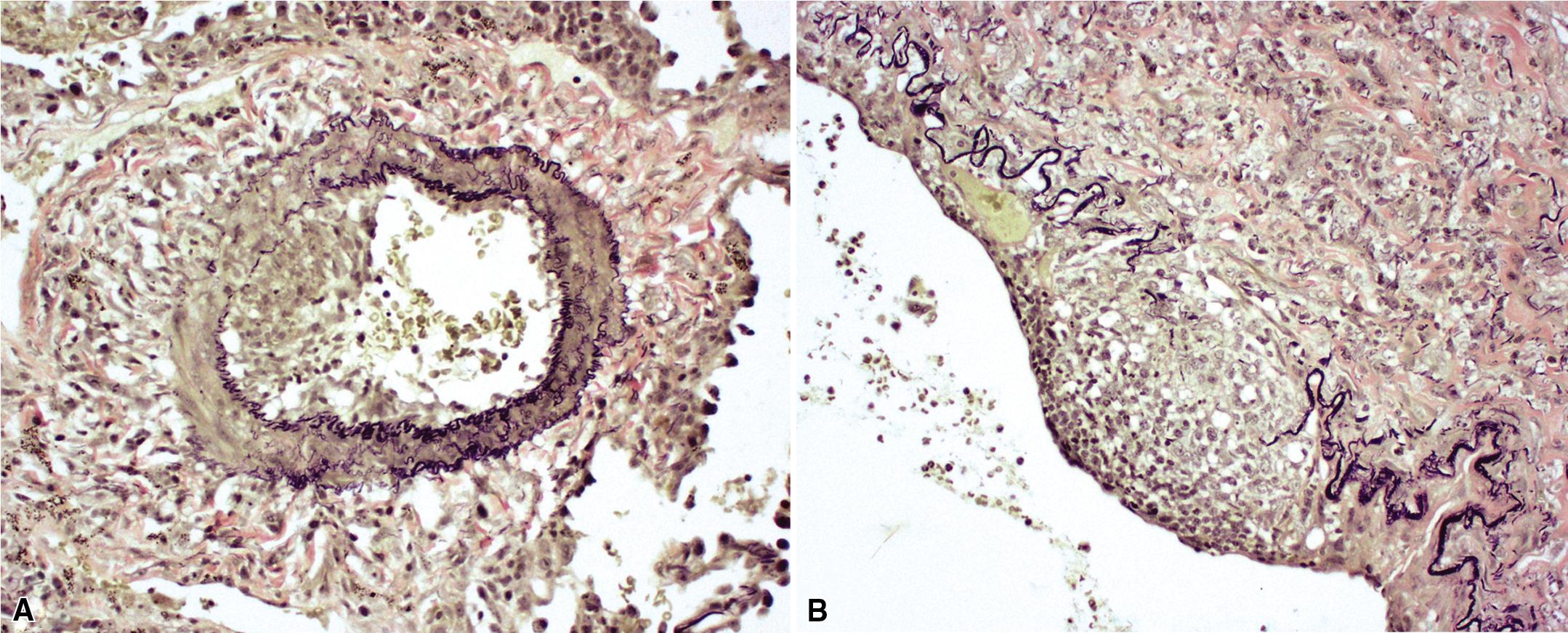
As mentioned, all types of inflammatory cells may occur in GPA, including neutrophils, lymphocytes, plasma cells, eosinophils, histiocytes, and giant cells. Occasionally the inflammatory infiltrate consists mostly of lymphoid cells, but this is unusual. In such cases, distinction of GPA from lymphomatoid granulomatosis may be difficult.
Another distinctive vascular manifestation of GPA is neutrophilic capillaritis characterized by neutrophils infiltrating alveolar walls ( Fig. 11.19 ). In many cases, capillaritis is only focally evident in the biopsy. When capillaritis is prominent, it is distinctive and easily recognized. In the rare case of GPA dominated by capillaritis, a careful search throughout the rest of the biopsy should be made for more typical findings of GPA such as granulomas, foci of necrosis (such as neutrophilic microabscesses), multinucleate giant cells, and vasculitis affecting arterioles or veins.
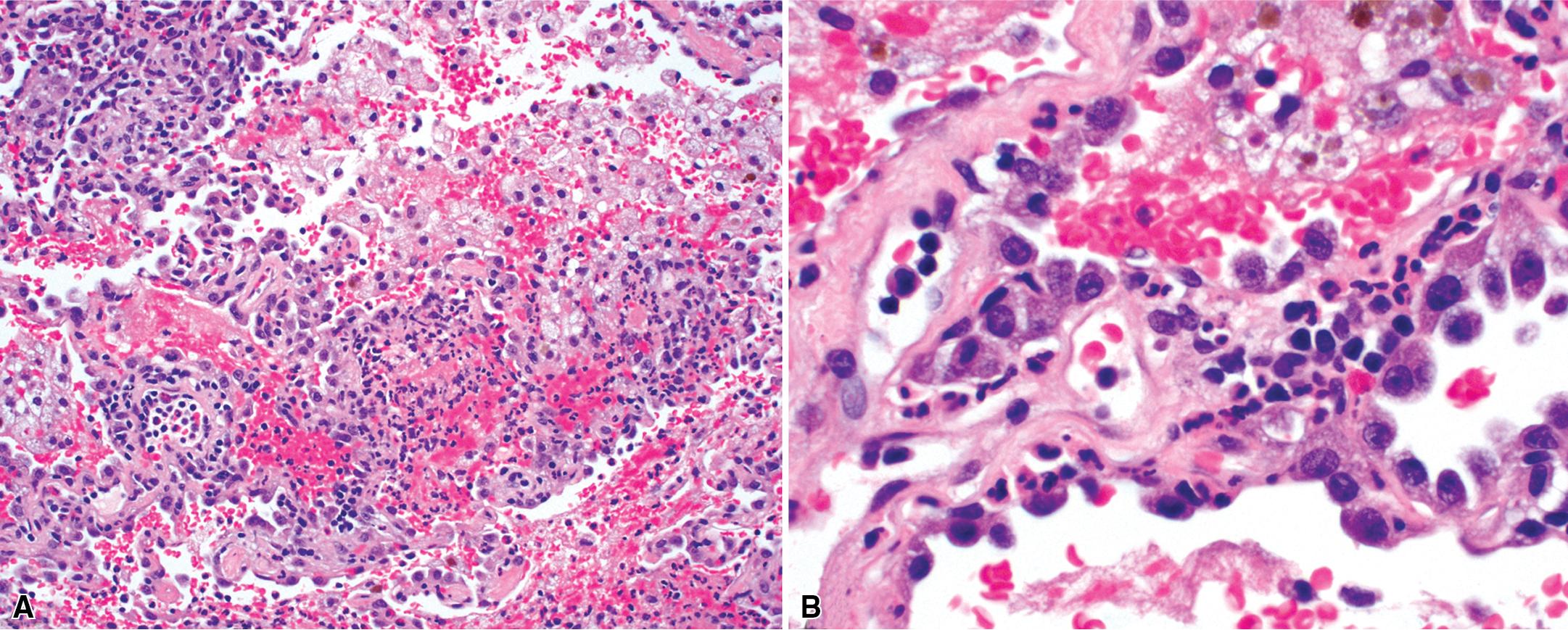
In addition to these major histologic features, a variety of minor histologic features may be encountered ( Box 11.3 ), including alveolar hemorrhage, interstitial fibrosis, lipoid pneumonia, organizing pneumonia, lymphoid hyperplasia, extravascular tissue eosinophils, and xanthomatous lesions. GPA can also involve the airways, causing chronic bronchiolitis, acute bronchiolitis or bronchopneumonia, the histologic pattern of organizing pneumonia (see later on), bronchocentric granulomatosis, follicular bronchiolitis, and bronchial stenosis. , Occasionally one of these minor lesions may be the dominant lung biopsy finding. Diffuse pulmonary hemorrhage is a severe life-threatening manifestation of GPA. The pattern of bronchocentric granulomatosis is another rare manifestation of GPA encountered in 1% of cases. , Organizing pneumonia ( Fig. 11.20 ) can be seen in 70% of lung biopsies from patients with GPA; rarely, it may be sufficiently dominant that some have referred to this manifestation as the bronchiolitis obliterans organizing pneumonia (BOOP) variant of GPA. , This should not be confused with the entity previously referred to as “idiopathic BOOP” (now cryptogenic organizing pneumonia) but should be recognized as nonspecific secondary organization following alveolar injury related to the underlying lesions of GPA.
Nodular interstitial fibrosis
Endogenous lipoid pneumonia
Alveolar hemorrhage
Organizing intraluminal fibrosis
Lymphoid aggregates
Tissue eosinophils
Xanthogranulomatous lesions
Alveolar macrophage accumulation
Chronic bronchiolitis
Acute bronchiolitis/bronchopneumonia
Bronchiolitis obliterans or a BOOP histologic pattern
Bronchocentric granulomatosis
Follicular bronchiolitis
Bronchial stenosis
BOOP , Bronchiolitis obliterans organizing pneumonia.
Note: May uncommonly represent a dominant pathologic feature.
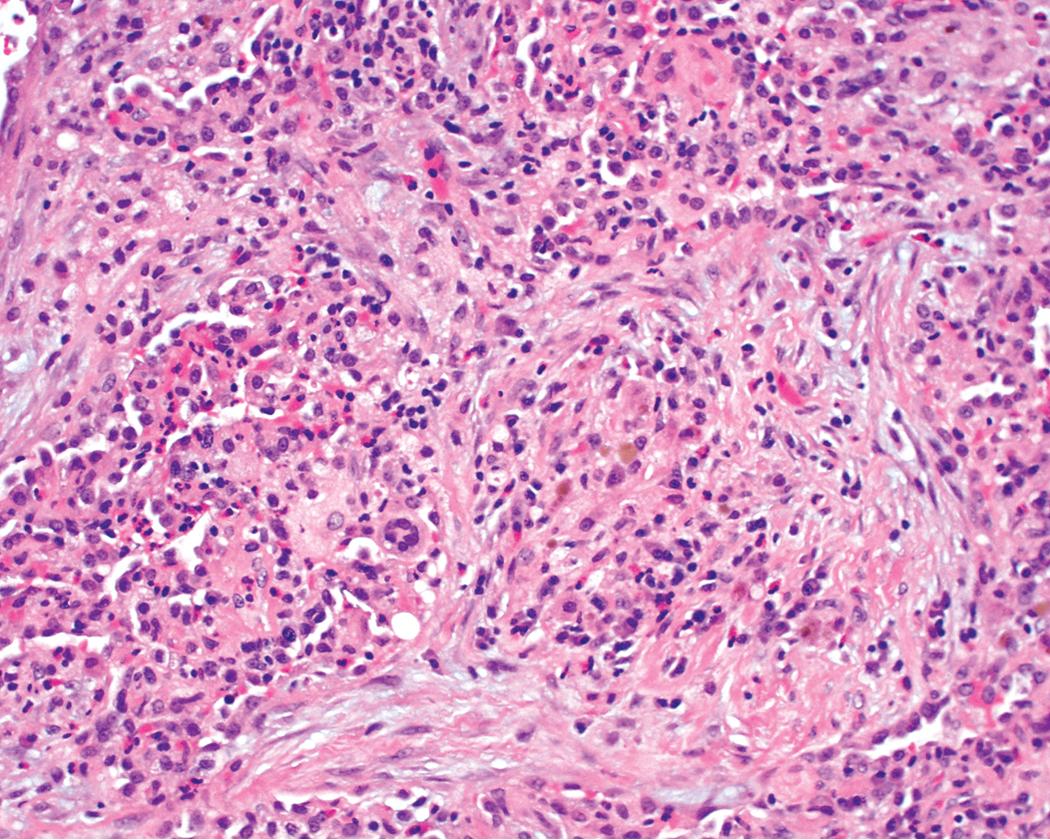
The lung biopsy findings from patients with GPA may not show classic histologic findings, especially if patients are biopsied very early in the course of disease or following therapy. , Interstitial fibrosis (sometimes with scattered giant cells, but without necrosis) ( Fig. 11.21 ), bronchial or bronchiolar scarring, and cicatricial vascular changes ( Fig. 11.22 ) are common in lung biopsies from patients who have received therapy. , Wedge biopsies provide the best results for an accurate diagnosis of GPA. Transbronchial biopsies rarely yield diagnostic information, although in the appropriate clinical context the presence of a few neutrophil microabscesses, giant cells, or capillaritis may be helpful in supporting the diagnosis. Transthoracic needle core biopsies may occasionally show features suggesting a diagnosis of GPA.

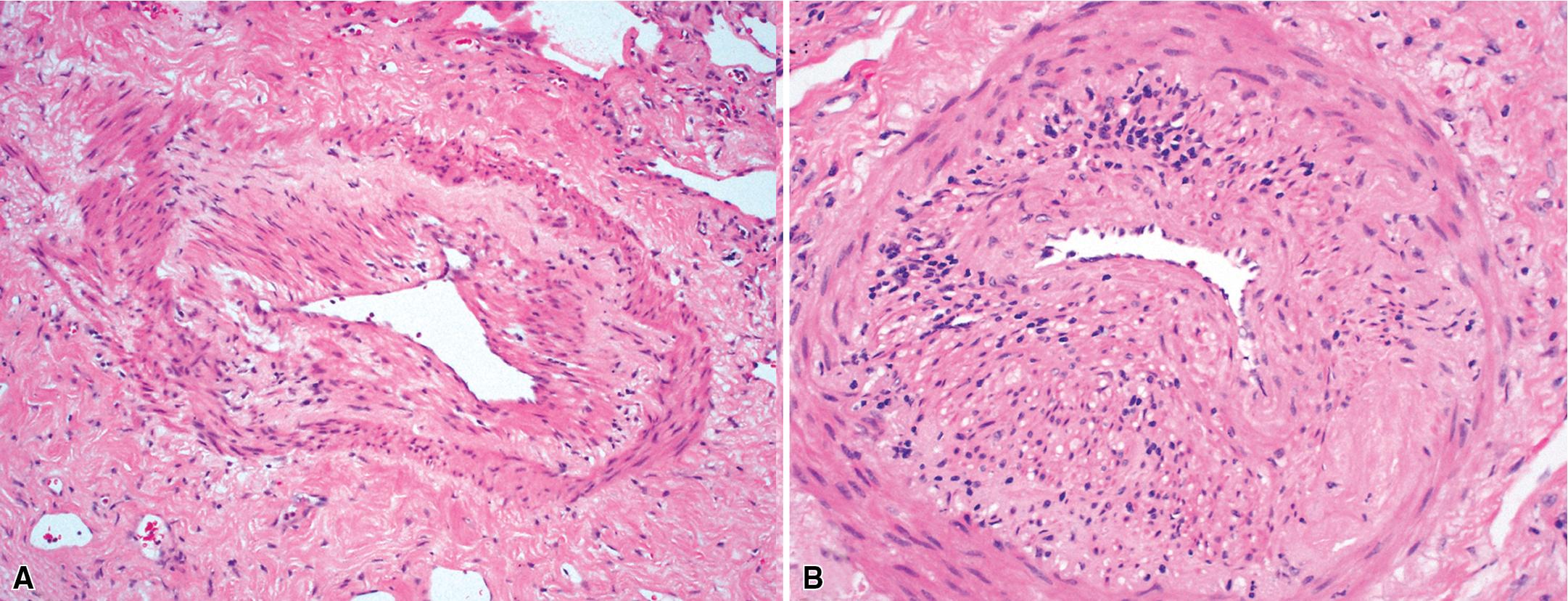
The differential diagnosis for GPA based on lung biopsy tissue depends somewhat on the constellation of changes present and includes granulomatous infection, lymphomatoid granulomatosis, , EGPA, sarcoidosis, necrotizing sarcoid granulomatosis, rheumatoid nodules, bronchocentric granulomatosis, , , and diffuse pulmonary hemorrhage syndromes. ,
Occasionally, a form of diffuse large B cell lymphoma commonly referred to as lymphomatoid granulomatosis (see Chapter 16 ) can bear a striking resemblance to GPA ( Fig. 11.23 ). Like classic GPA, this neoplastic process is characterized pathologically by the presence of multiple necrotic pulmonary nodules. In addition to major clinical differences between these diseases, important histopathologic differences become evident at closer inspection. First, the necrotic areas in lymphomatoid granulomatosis typically demonstrate pale shadows of large necrotic cells (dead lymphoma cells). Second, within the necrotic zones, and at the periphery of necrosis, medium-sized blood vessels can be seen whose outline is expanded by an angiocentric infiltration of lymphoid cells. The atypical lymphoid cells are B-cells infected with Epstein–Barr virus (EBV) and associated with a T lymphocyte–rich inflammatory reaction and vasculitis. In high-grade disease, the vasocentric infiltrate is composed mainly of large atypical B cells. In lower-grade forms, the infiltrate may be polymorphous with more prominent T cells and a mixture of plasma cells and eosinophils. Immunohistochemistry for CD20 and CD3 highlights the large malignant B cells and background of inflammatory T cells. Immunohistochemistry for EBV latent membrane protein 1 (LMP-1) and in situ hybridization studies for EBV are valuable diagnostic tools in this setting. Third, lymphomatoid granulomatosis is a vasodestructive lymphoid neoplasm, so necrosis and obliteration of vessels are common. GPA may show necrosis in vascular adventitia, but wholesale medial necrosis in arteries and veins is unusual. Fourth, the atypical cells of lymphomatoid granulomatosis often contain EBV, , a finding not expected in GPA. Finally, in spite of the name, granulomatous inflammation is comparatively rare in lymphomatoid granulomatosis, so the presence of granulomas in nodular lung lesions should suggest a diagnosis other than lymphomatoid granulomatosis (e.g., infection or GPA).

Prominent tissue eosinophilia occurs in approximately 5% of cases of GPA ( Fig. 11.24 ). With this finding, the differential diagnosis should include EGPA (see later), along with fungal or parasitic infection. , , , Peripheral blood eosinophilia is characteristic of EGPA and is uncommon in GPA. Also, asthma is not a characteristic feature of GPA, although rarely, asthmatic individuals may develop GPA, presumably at a rate similar to that seen in the general population. The distinction between GPA and EGPA is usually straightforward, but some cases may require careful assessment of all of the clinical, pathologic, and laboratory data ( Table 11.3 ).
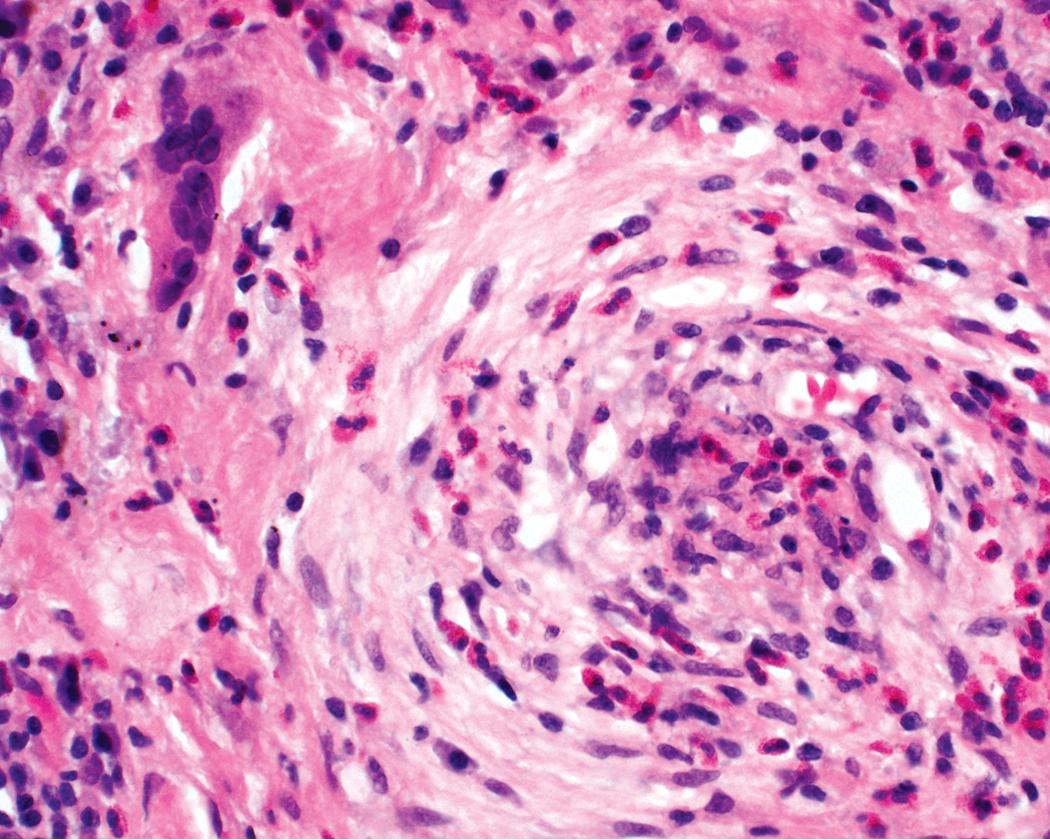
| Clinical/Pathologic Feature | Granulomatosis With Polyangiitis | Eosinophilic Granulomatosis With Polyangiitis |
|---|---|---|
| Asthma | Rare | Characteristic (diagnostic criterion) |
| Eosinophilia | ||
|
Up to 12% | Characteristic a |
|
Up to 6% | Characteristic a |
| Sinus disease | Destructive, often causing saddlenose deformity | Less severe, usually allergic rhinitis |
| Renal disease | More severe | Usually mild |
| Cardiac disease | Rare | Common |
| ANCA | Usually c-ANCA | Usually p-ANCA |
a Eosinophilia may be fleeting and may be difficult to demonstrate during steroid therapy.
Perhaps the most important, and often problematic, consideration in the diagnosis of GPA is the exclusion of infection. Mycobacteria and fungi can cause necrotizing granulomatous inflammation and vasculitis resembling that seen in GPA. Solitary necrotizing granulomas can be associated with vasculitis in 87% of mycobacterial lung infections and 57% of fungal lung infections. Also, neutrophilic microabscesses are a feature of certain infections, such as blastomycosis and nocardiosis.
A number of important clues can be helpful in the approach to this differential diagnosis, even before special stains for organisms or culture data (which should be routinely ordered in such cases) are available. First, if the lesion is solitary, a high index of suspicion for infection is appropriate. Second, GPA does not tend to make granulomas without central necrosis, except in the rare occurrence of infection superimposed on the necrotic center of a GPA lesion. Third, the necrosis of infection may show the ghosted outlines of underlying lung parenchyma, a finding uncharacteristic of GPA, as GPA necrosis destroys the affected lung. Fourth, the patient with infection, in whom a bilateral multiple-nodular appearance on radiologic studies may simulate that in GPA, is typically quite ill, with generalized systemic symptoms. By contrast, the patient with GPA may be relatively asymptomatic, despite numerous necrotic nodules in the lung. Finally, when strictly morphologic assessment fails to clarify the diagnosis, inquiry regarding the presence of sinonasal disease or renal disease and serologic data (ANCA studies) will usually resolve the quandary.
When GPA presents with a predominantly bronchocentric pattern of lung involvement, bronchocentric granulomatosis must be considered in the differential diagnosis. , Patients with bronchocentric GPA should demonstrate other distinguishing features of GPA, including renal or sinus involvement and a positive ANCA serology.
The histologic features of GPA can be very suggestive of the diagnosis, but generally, it is extremely important to correlate the histopathology with clinical and serologic findings before making a definitive diagnosis on a lung biopsy specimen. The diagnosis can be impossible to make in cases in which only partial clinical or pathologic criteria are present. In these situations a purely descriptive diagnosis with a differential diagnosis may be necessary. As mentioned earlier, ANCA serology can be helpful, as long as one keeps in mind that ANCAs are not specific for GPA. Moreover, when all other clinical and histopathologic findings are compelling for GPA, the diagnosis is still possible despite negative ANCA studies.
GPA is commonly a fatal disease if left untreated, with up to 90% of patients dying within 2 years of diagnosis, most often from respiratory or renal failure. Fortunately, the 5-year survival has been steadily rising following the introduction of immunosuppressant therapy. Treatment typically consists of glucocorticoids such as prednisone combined with either cyclophosphamide or rituximab. In one study, therapy with cyclophosphamide and prednisone was very effective in achieving remissions, with 85% to 90% of patients responding to therapy and approximately 75% experiencing complete remission. The median time to remission is 12 months, although occasional patients require treatment for more than 2 years before all symptoms resolve. Even in those patients who initially respond to therapy, relapses are common, with up to 50% of initial responders experiencing at least one relapse requiring another course of therapy. Several clinical trials, either completed or ongoing, have attempted to define the optimal dosage and combination of these agents for induction of therapy and maintenance of remission. Mycophenolate mofetil, methotrexate, azathioprine, and leflunomide may also provide benefit as steroid-sparing agents. Plasma exchange and intravenous immunoglobulins have shown some benefit in refractory disease. , The outcome with GPA seems to be significantly worse for patients older than 60 years of age than for younger patients, despite similar clinical manifestations and treatment regimen. Lung function frequently improves after treatment, but in some patients the diffusing capacity may never return to normal.
EGPA, also known as CSS or allergic angiitis and granulomatosis, is a multisystem disorder characterized by the triad of asthma, peripheral blood eosinophilia, and vasculitis. , , , , , Although EGPA was initially described by Churg and Strauss based on a series of autopsy cases, it is now recognized primarily as a clinical entity. Accordingly, most cases today are diagnosed on the basis of clinical findings rather than lung biopsy. ,
In 1990 the ACR proposed two approaches to the diagnosis of EGPA ( Table 11.4 ): a traditional format classification and a classification tree. , The ACR system is most commonly used although other proposed systems exists such as the updated ACR/EULAR classification According to the traditional format classification by the ACR, six criteria are identified: (1) asthma, (2) eosinophils greater than 10% of the white blood cell differential count, (3) mononeuropathy (including multiplex) or polyneuropathy, (4) nonfixed radiographic pulmonary infiltrates, (5) paranasal sinus abnormalities, and (6) a biopsy containing a blood vessel with extravascular eosinophils. If 4 of these 6 criteria are met, the diagnosis can be established with a sensitivity of 85% and a specificity of 99.7%. The ACR criteria for EGPA have been retained in the subsequent 1994 Chapel Hill consensus conference criteria.
| Manifestation | Frequency (% of Patients Affected) |
|---|---|
| Pulmonary infiltrates | 72 |
| Mononeuritis multiplex | 66 |
| Abdominal pain | 59 |
| Arthritis/arthralgias | 51 |
| Mild/moderate renal disease | 49 |
| Purpura | 48 |
| Cardiac failure | 47 |
| Myalgia | 41 |
| Löffler syndrome | 40 |
| Erythema/urticaria | 35 |
| Diarrhea | 33 |
| Pericarditis | 32 |
| Skin nodules | 30 |
| Pleural effusion | 29 |
| Hypertension | 29 |
| Central nervous system abnormalities | 27 |
| Gastrointestinal bleeding | 18 |
| Renal failure | 9 |
The major criteria used in the classification tree are asthma, eosinophilia with greater than 10% eosinophils, and a history of allergy. According to this method, patients with well-documented systemic vasculitis, but lacking a history of asthma, can be diagnosed with EGPA if they have peripheral blood eosinophilia (>10% eosinophils) and a history of allergy other than drug sensitivity. This seems appropriate because patients without asthma but with a history of allergic disease can develop EGPA.
Both classification methods appear to be useful in the diagnosis, with greater sensitivity provided by the classification tree and greater specificity by the traditional approach.
EGPA occurs in a wide age range (7–74 years; mean 38–54 years) and has an estimated incidence of 0.11 to 2.66 per million per year. No gender or ethnic predisposition has been demonstrated.
The exact etiology of EGPA remains unknown. Insights into the pathogenesis of EGPA have expanded in recent years with suggestions that the mechanisms underlying EGPA might be different from those of GPA and MPA. Although an ANCA-associated vasculitis, the prevalence of ANCA positivity in EGPA is only around 40% and is typically perinuclear MPO-ANCA. One genome-wide association study demonstrated that MPO-ANCA positive EGPA and MPO-ANCA negative GPA are potentially two genetically distinct subtypes. Genes that influence eosinophil numbers and underlie asthma are shared by both groups; however AMCA-MPO negative EGPA is associated with genes implicating mucosa dysfunction as a primary mechanism, as opposed to MPO-ANCA positive EGPA which is associated with HLA abnormalities implying an eosinophilic autoimmune disease. Eosinophil dysfunction in general has also been implicated in pathogenesis via inducement of pro-inflammatory mediators affecting TH2 cells and group 2 innate lymphoid cells, which, in turn, produce IL-5 and IL-13 which further promote eosinophil proliferation. Increased IgG4 has been observed, suggesting EGPA may be related to the ever-expanding list of IgG4-related disorders. ,
EGPA mainly involves the upper respiratory tract, lungs, skin, and peripheral nerves. , , Involvement of the heart and kidney also occurs and may be associated with a worse outcome.
EGPA often progresses through three distinct phases. In the early or prodromal phase , the disease manifests as allergic rhinitis, asthma, peripheral eosinophilia, and/or eosinophilic infiltrative disease. , , , Recurrent episodes of asthma may develop over a period of years before the onset of vasculitis, and some data suggest that the interval between the onset of asthma and the subsequent vasculitis phase of the disease has a direct association with prognosis. , , In the prodromal phase , tissue infiltration by eosinophils can affect the lungs or the gastrointestinal tract. Pulmonary manifestations may take the form of Löffler syndrome, with fleeting pulmonary infiltrates or even chronic eosinophilic pneumonia.
The prodromal phase is followed by the vasculitis phase . During this phase, patients develop systemic signs and symptoms of vasculitis, such as mononeuritis multiplex and cutaneous leukocytoclastic vasculitis. Results of the p-ANCA assay are usually positive. The ACR criteria necessary for diagnosis are present only during this phase. Unfortunately, most of the permanent damage is done by the disease during this phase. For this reason, when eosinophilic pneumonia occurs in an asthmatic patient, EGPA should always be raised as a possibility in the differential diagnosis, especially when prominent eosinophilic vasculitis is present in the lung biopsy.
The vasculitis phase is followed by a post-vasculitis phase . Here, patients may experience neuropathy and hypertension, typically with persistent asthma and allergic rhinitis. Proteinuria and gastrointestinal involvement are poor prognostic indicators.
A major difference between EGPA and GPA is the frequency of cardiac and renal involvement. Although the heart may be involved in both disorders, up to 47% of EGPA patients develop cardiac disease. EGPA can cause cardiac failure, pericarditis, hypertension, and acute myocardial infarction. , , Also, although renal disease is characteristic in GPA, it is less frequent and less severe in patients with EGPA. , ,
Peripheral neuropathy, often in the form of mononeuritis multiplex, is seen in approximately two-thirds of patients with EGPA. The most common cutaneous manifestation is leukocytoclastic vasculitis. Sinonasal manifestations include nasal obstruction, nasal polyps, rhinorrhea, and thick intranasal crusts. Central nervous system involvement can occur in 25% of cases. , , Gastrointestinal hemorrhage and perforation are potential complications. Serologic studies usually show the p-ANCA pattern, although c-ANCA can also be seen (the inverse of ANCA types in GPA). Elevated serum IgE is also a characteristic finding in EGPA. , ,
An EGPA-like syndrome develops as a rare complication in steroid-dependent asthmatics successfully treated with leukotriene receptor antagonists (e.g., pranlukast). This complication is probably related to steroid withdrawal facilitated by the drugs, which unmasks underlying EGPA, rather than a manifestation of the drugs. To this point, a similar unmasking of EGPA has occurred in asthmatic patients whose withdrawal from oral steroids was facilitated by inhaled steroids. Also, an unusual association between an EGPA-like vasculitis and the illicit use of free base cocaine has been reported. Drug-induced vasculitides in general have been particularly associated with p-ANCA/MPO-ANCA vasculitis as opposed to PR3-ANCA, although the mechanism is unclear.
There are no laboratory tests specific for EGPA. Peripheral blood eosinophilia (eosinophil counts usually 5000–9000/μL) is the most characteristic finding. Other nonspecific laboratory abnormalities include normochromic normocytic anemia, markedly elevated erythrocyte sedimentation rate, leukocytosis, elevated IgE level, and hypergammaglobulinemia. Bronchoalveolar lavage fluid shows a high percentage of eosinophils (usually >33%). Pulmonary function abnormalities most often reflect the patient’s underlying asthma.
EGPA most commonly manifests radiologically as multifocal lung parenchymal infiltrates that change in location and size over time ( Fig. 11.25 ). , , The infiltrates may also exhibit a peripheral distribution, thereby mimicking those of chronic eosinophilic pneumonia. Lung involvement by pulmonary consolidation may be widespread. Diffuse miliary nodules have also been reported. , Cavitation of nodules is rare and when present should suggest superimposed infection. Eosinophilic pleural effusions may be seen in 29% of cases. , Hilar lymphadenopathy is infrequent. The chest radiograph can be normal in appearance in as many as 25% of patients.
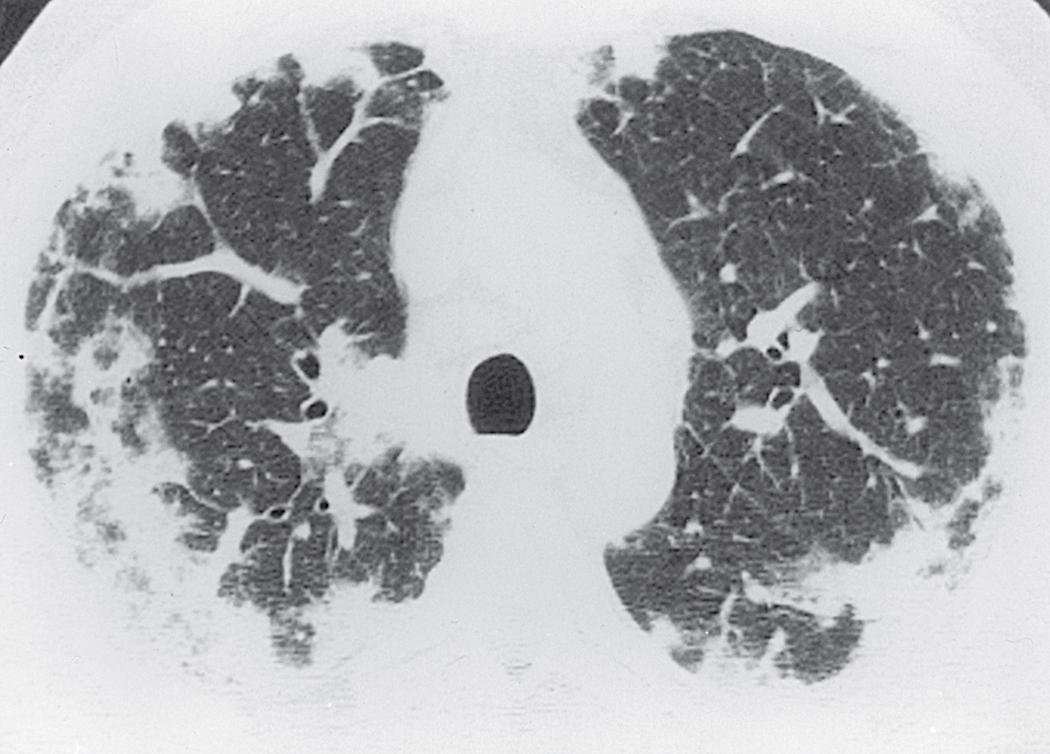
High-resolution CT (HRCT) features of EGPA most commonly consist of parenchymal opacifications (consolidation or ground-glass attenuation), followed in frequency by pulmonary nodules, bronchial wall thickening or dilatation, interlobular septal thickening, and normal anatomy. One case report described “stellate-shaped” peripheral pulmonary arteries and peribronchial and septal interstitial thickening. Small patchy opacities were also noted. These HRCT abnormalities correlated with eosinophilic infiltration and foci of eosinophilic pneumonia, respectively.
The findings on lung biopsy depend on the stage of the disease during which the biopsy is obtained and whether the patient has received therapy, particularly steroids. Lung biopsies from EGPA patients in the full-blown vasculitic phase may show asthmatic bronchitis, eosinophilic pneumonia ( Fig. 11.26 ), extravascular stellate granulomas ( Fig. 11.27 ), and vasculitis ( Fig. 11.28 ). , In some cases, the inflammatory lesions extend along the pleura and interlobular septa. The extravascular granulomas have a border of palisaded histiocytes and multinucleate giant cells, surrounding a central necrotic zone replete with eosinophils and eosinophil cellular debris. Such lesions have been called allergic granulomas . Vasculitis can affect arteries, veins, or capillaries. The vascular inflammatory infiltrates can be composed of chronic inflammatory cells, eosinophils, epithelioid cells, multinucleate giant cells, and neutrophils. Diffuse pulmonary hemorrhage and capillaritis ( Fig. 11.29 ) can be seen. , In patients who are partially treated, the pathologic (and clinical) features may be incomplete. Lung biopsy is not required for diagnosis if pulmonary infiltrates are present in association with other systemic findings that fulfill the required diagnostic criteria.
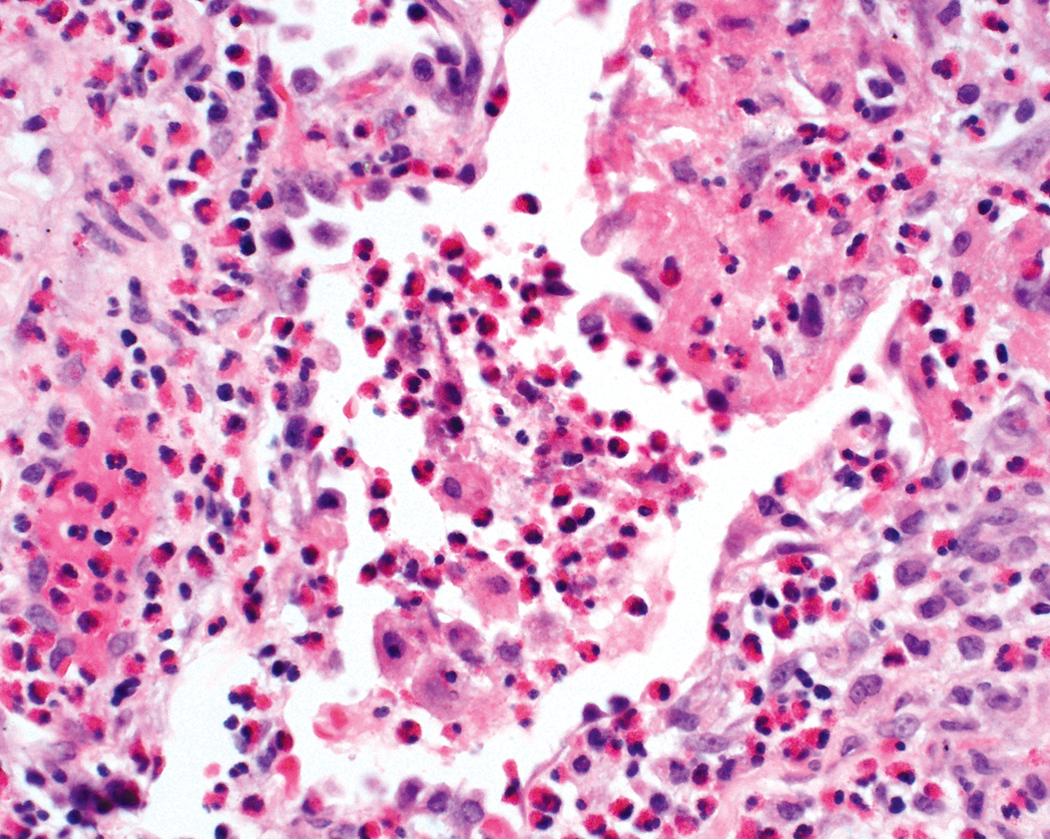
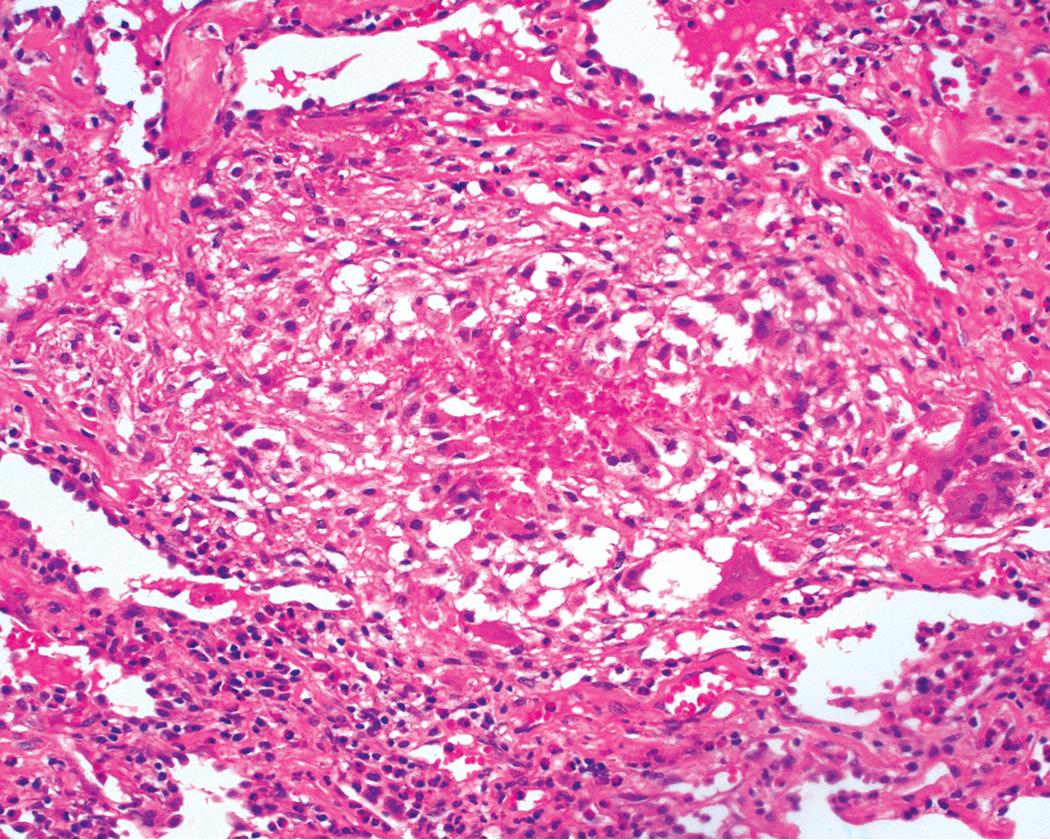
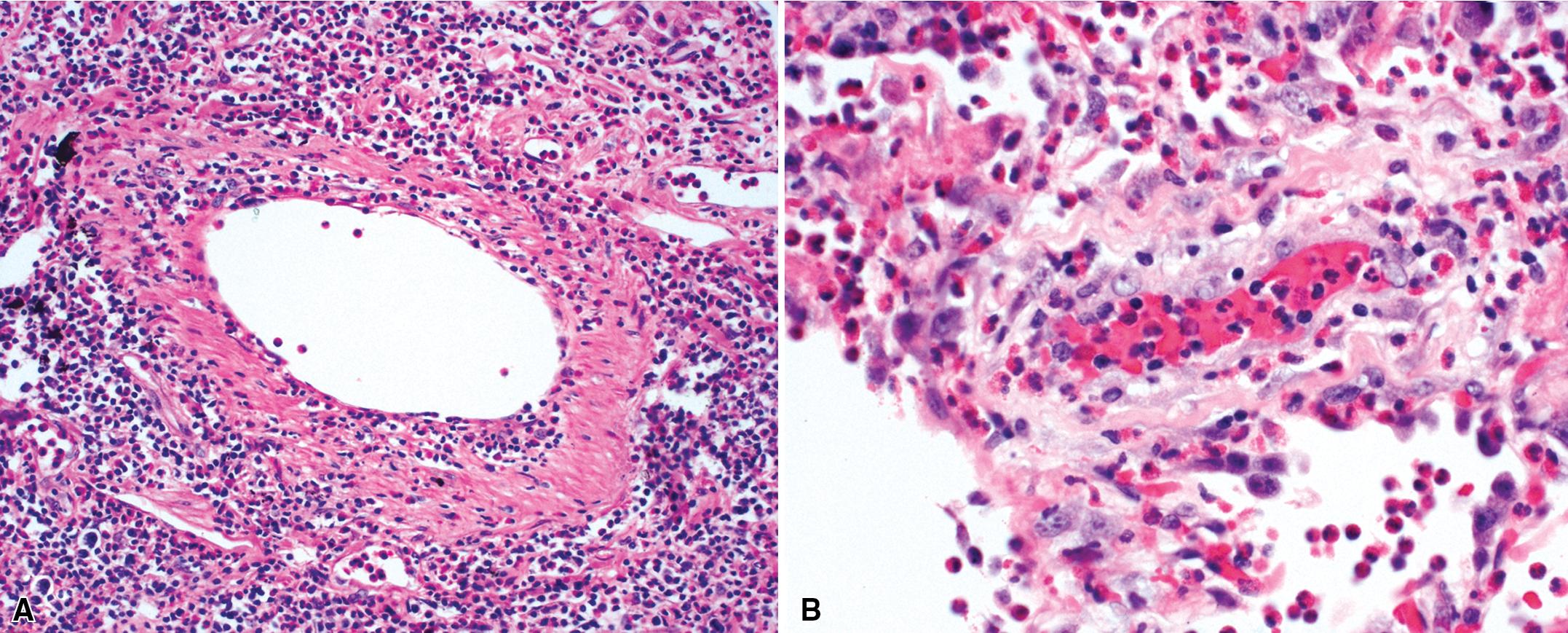
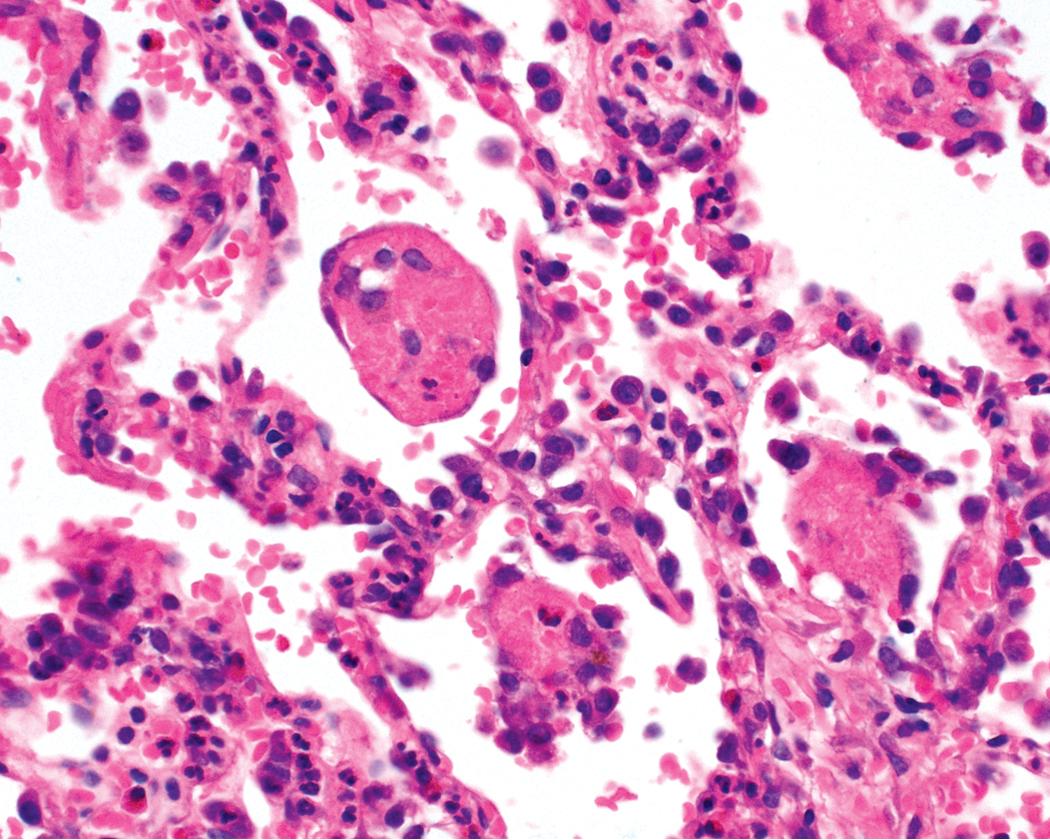
The differential diagnosis of EGPA includes eosinophilic pneumonia from any cause, GPA, allergic bronchopulmonary fungal disease (ABPFD), infection (especially parasitic and fungal), Hodgkin disease, and drug-induced vasculitis.
Eosinophilic pneumonia and ABPFD lack systemic vasculitis, although some cases of eosinophilic pneumonia can show a mild non-necrotizing vasculitis, and allergic granulomas may be present. Features helpful in distinguishing EGPA from GPA are summarized in Table 11.3 . Pathologic features similar to those of EGPA can also be mimicked by certain parasitic infections, such as those caused by Strongyloides stercoralis and Toxocara canis . Therefore parasitic infection should be carefully excluded when EGPA is in the differential diagnosis on histopathologic grounds. Some fungal infections, especially those due to Aspergillus species and Coccidioides immitis , may be associated with granulomatous inflammation, prominent eosinophilia, and vasculitis. Rarely, Hodgkin disease with prominent eosinophils and vascular inflammation may be confused with EGPA. Drugs such as carbamazepine also can cause an EGPA-like syndrome, so attention should be paid to the patient’s drug history.
Most patients with EGPA respond to systemic corticosteroids. To avoid irreversible organ injury, some authorities have favored treatment with cytotoxic immunosuppressive agents, such as cyclophosphamide, from the outset. Azathioprine, interferon-α, and high-dose intravenous immune globulin have been used with apparent benefit in patients with severe, fulminant disease or in patients unresponsive to systemic corticosteroids. Plasma exchange has occasionally been used but appears to have no added benefit to that observed with treatment with systemic corticosteroids, with or without the addition of cyclophosphamide. Rituximab has shown less efficacy in EGPA compared to GPA or MPA, although mepolizumab, a monoclonal antibody targeting interleukin 5, an eosinophil survival factor, has shown promise.
Patients who die from EGPA typically have cardiac complications such as congestive heart failure or myocardial infarction. Other, less common causes of death include renal failure, cerebral hemorrhage, gastrointestinal perforation or hemorrhage, status asthmaticus, and respiratory failure. ,
Microscopic polyangiitis (MPA) encompasses the spectrum of vasculitic disorders that previously have been called systemic necrotizing vasculitis, leukocytoclastic vasculitis, and hypersensitivity vasculitis.
An International Consensus Conference on the Nomenclature of Systemic Vasculitides defined MPA as a vasculitis restricted to arterioles, venules, and capillaries. The designation polyangiitis was favored over polyarteritis because venules are affected as well as arterioles. MPA differs from PAN, in that it involves arterioles, venules, and capillaries, as opposed to medium-sized arteries. ,
Systemic manifestations of MPA are more common than pulmonary manifestations and include glomerulonephritis (in 97% of the cases), fever (in 62%), myalgia and arthralgia (in 52%), weight loss (in 45%), ear, nose, and throat symptoms (in 31%), and skin involvement (in 17%) ( Table 11.5 ). , Approximately 50% of patients develop pulmonary involvement, and these persons are typically middle-aged or older (average age, 56 ± 17 years) when this occurs. Women are affected slightly more often than men (1.5:1 female-to-male ratio). Onset of symptoms is rapid in most patients, but up to 28% may have symptoms for more than 1 year before diagnosis.
| Manifestation | Number of Patients Affected ( n = 29) | Frequency (%) |
|---|---|---|
| Pulmonary | 29 | 100 |
|
26 | 90 |
|
26 | 90 |
|
23 | 79 |
|
5 | 17 |
|
13 | 45 |
| Renal | 28 | 97 |
| Fever (temperature >37.5°C) | 18 | 62 |
| Weight loss | 13 | 45 |
| Musculoskeletal | 15 | 52 |
|
13 | 4 |
|
4 | 14 |
|
6 | 21 |
| Ear, nose, and throat | 9 | 31 |
|
5 | 17 |
|
1 | 3 |
|
2 | 7 |
|
1 | 3 |
| Skin | 5 | 17 |
|
4 | 14 |
|
1 | 3 |
|
1 | 3 |
|
1 | 3 |
| Hypertension | 7 | 25 |
| Ocular | 7 | 25 |
|
5 | 17 |
|
2 | 7 |
| Peripheral neuropathy | 2 | 7 |
| Gastrointestinal bleeding | 1 | 3 |
Bronchoalveolar lavage fluid typically shows acute hemorrhage or hemosiderin-laden macrophages when the lungs are involved. Kidney biopsies may show a necrotizing glomerulonephritis. More than 80% of patients have a positive ANCA, most often demonstrating t MPO-ANCA, while approximately 25% will be associated with PR3-ANCA and a small number of cases will be ANCA negative. Despite clinical differences and heterogeneity compared to GPA, and although typically associated with MPO-ANCA instead of PR3-ANCA, the underlying pathogenesis of MPA is generally felt to be similar to that of GPA and different from EGPA. MPA is the most common cause of so-called pulmonary hemorrhage renal syndrome. ,
Become a Clinical Tree membership for Full access and enjoy Unlimited articles
If you are a member. Log in here